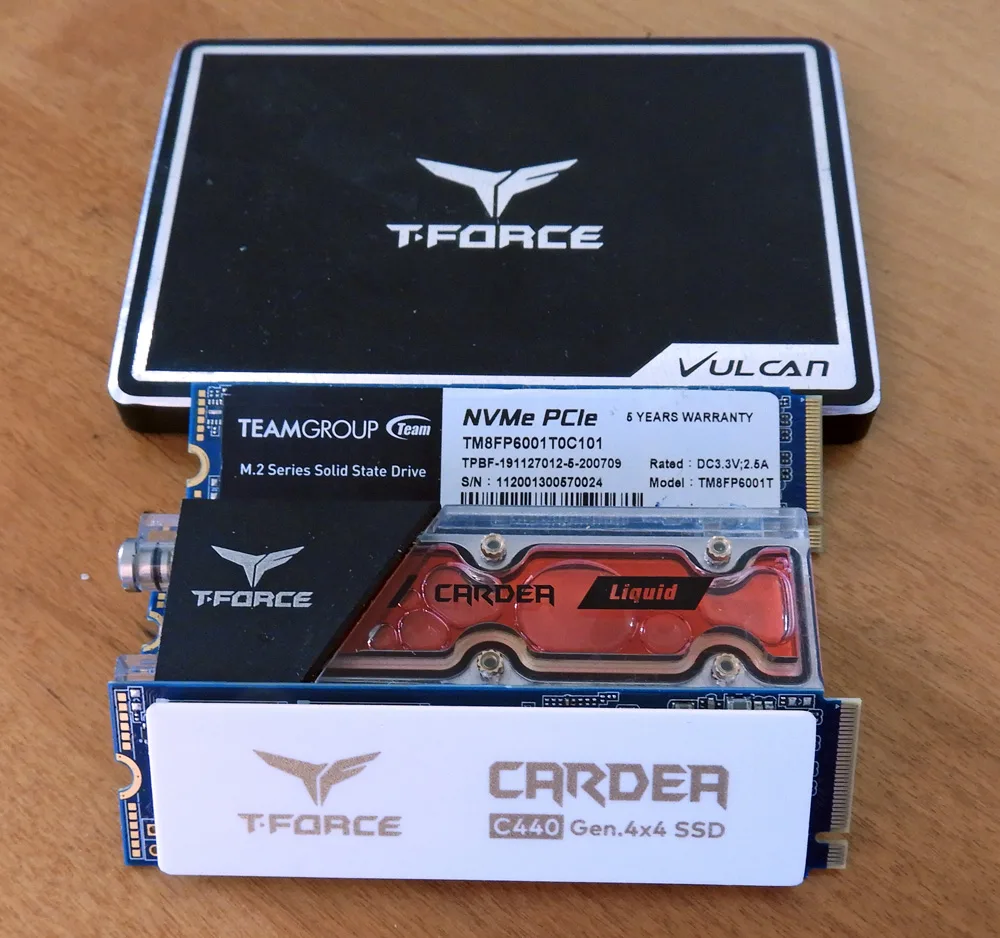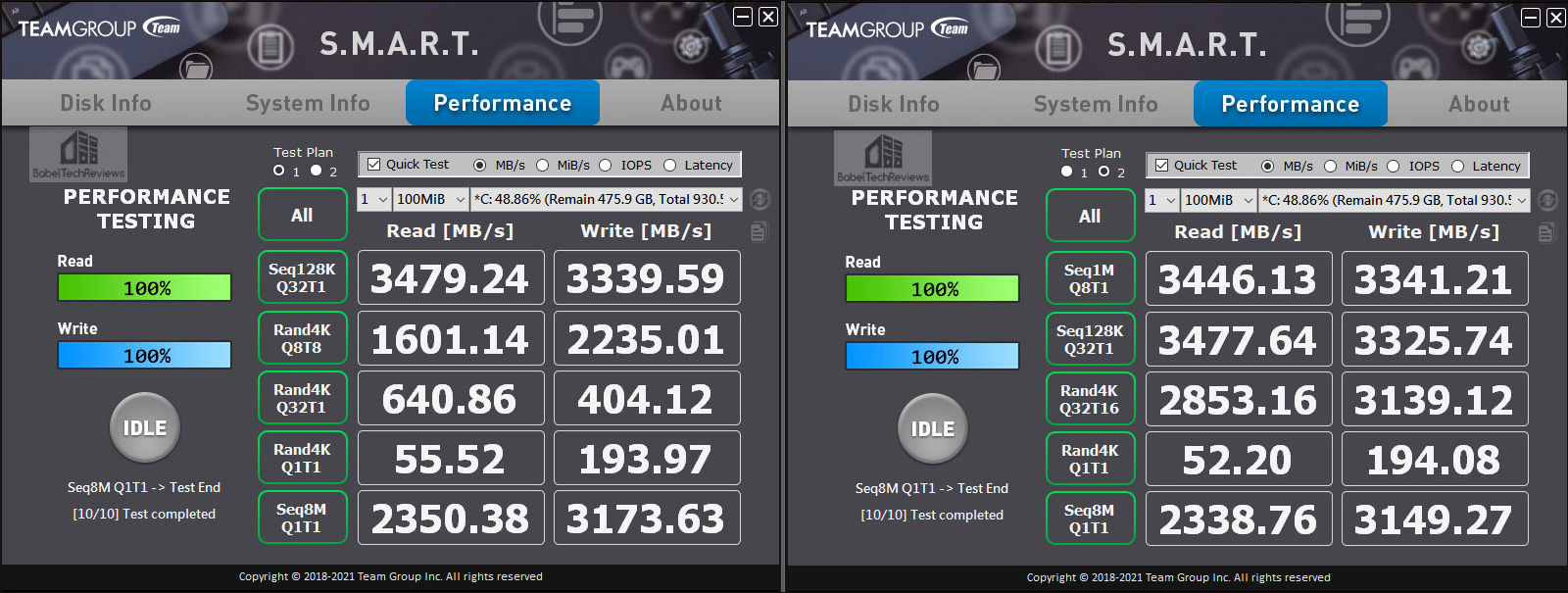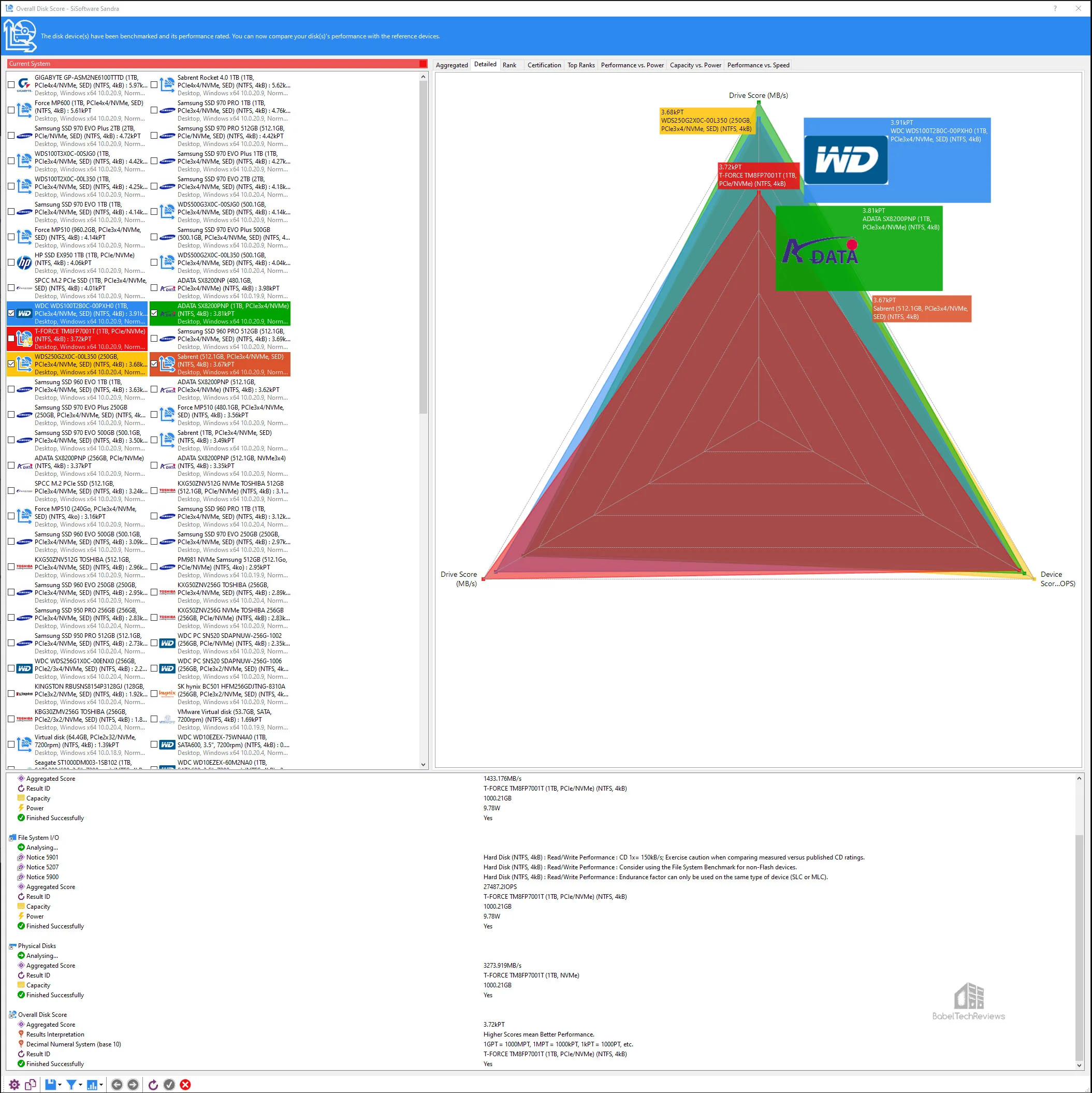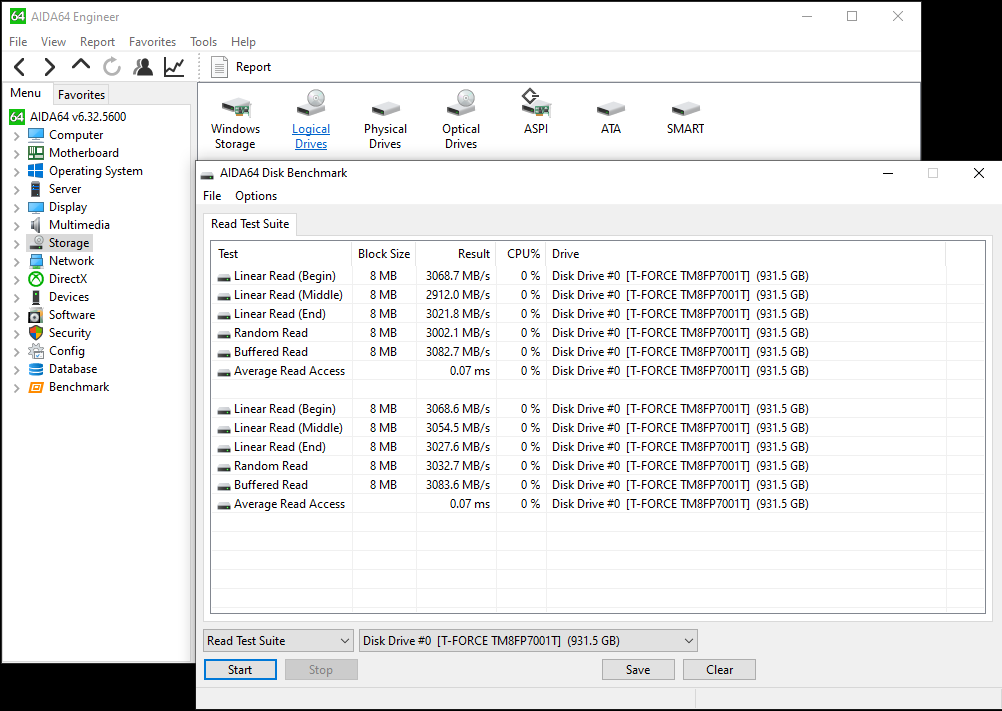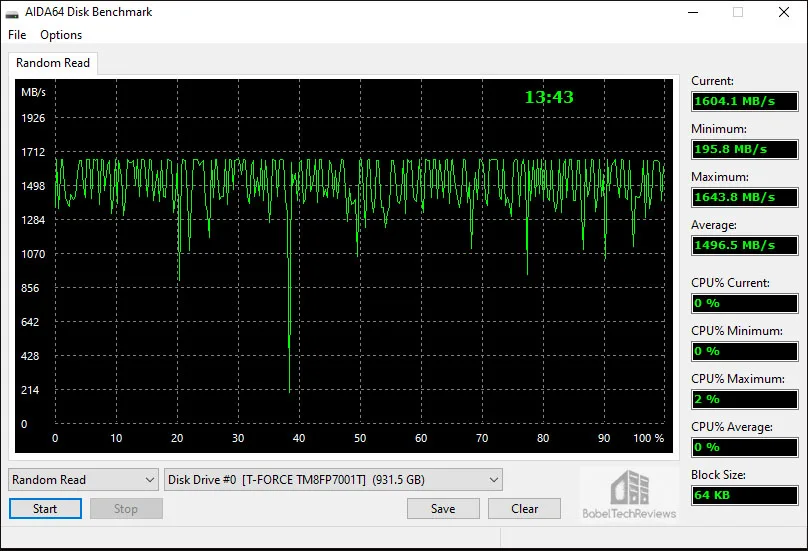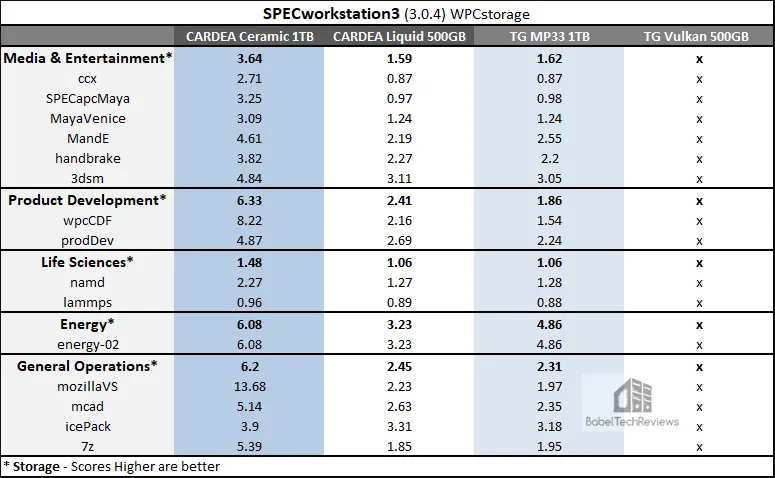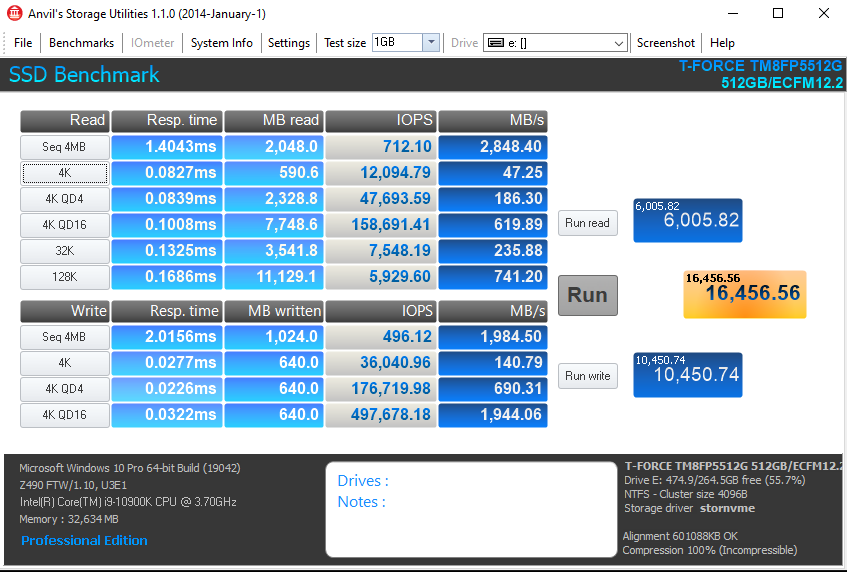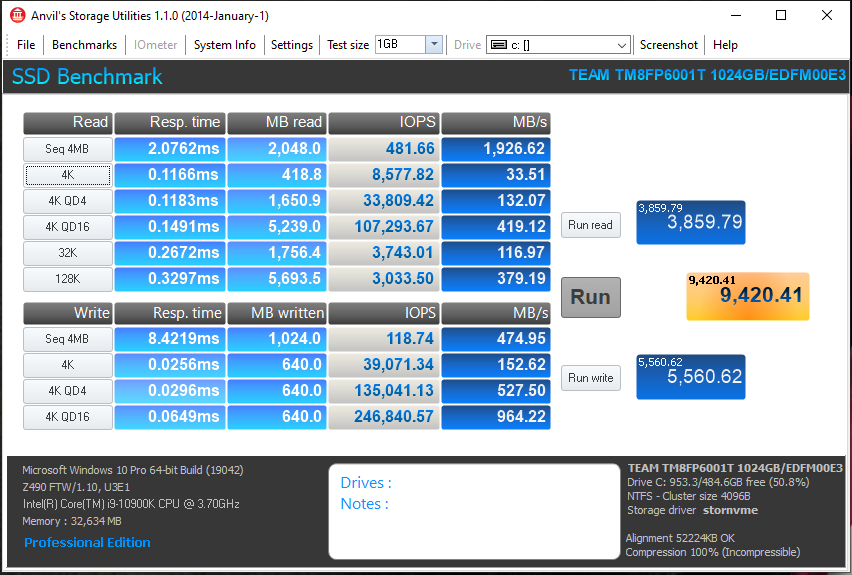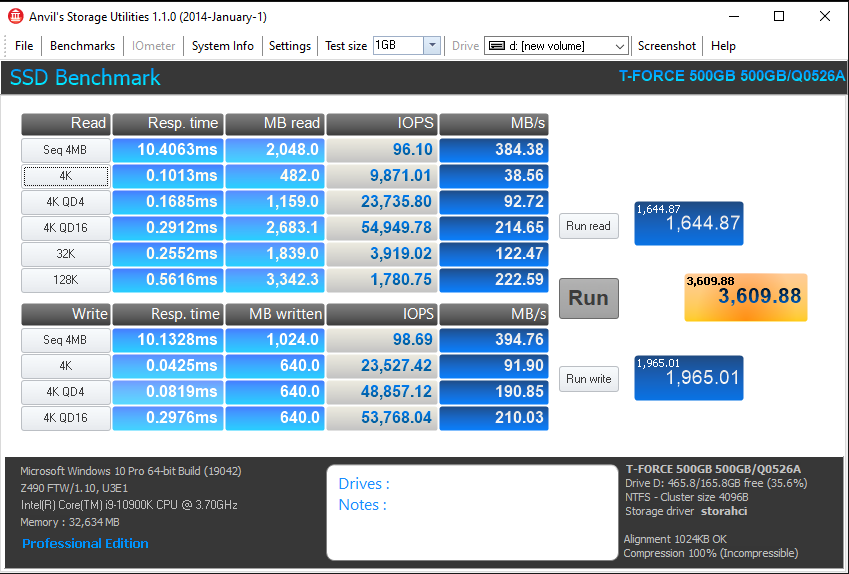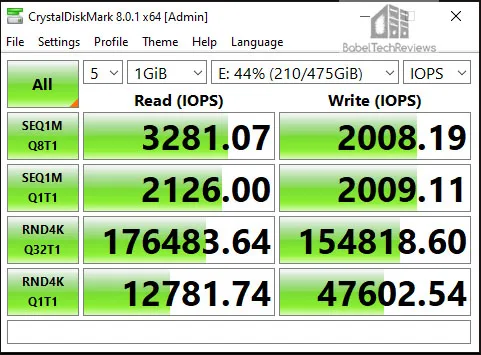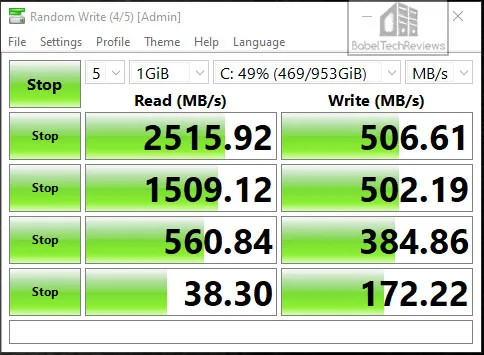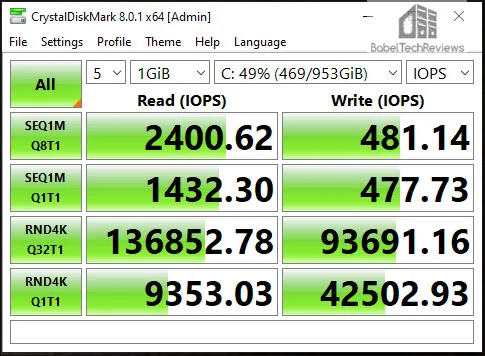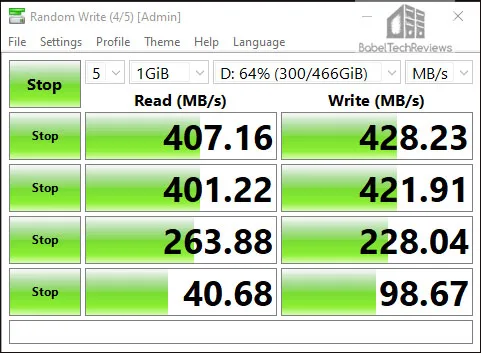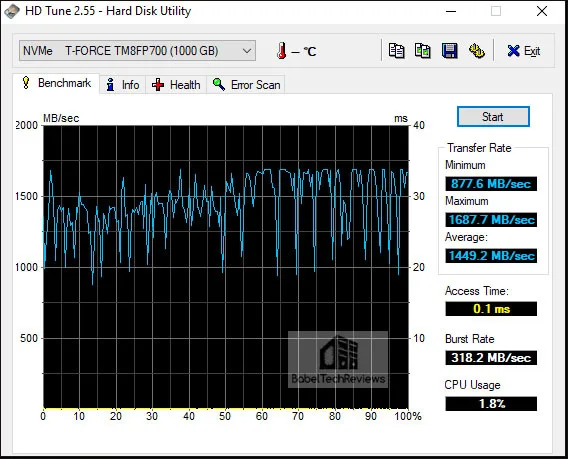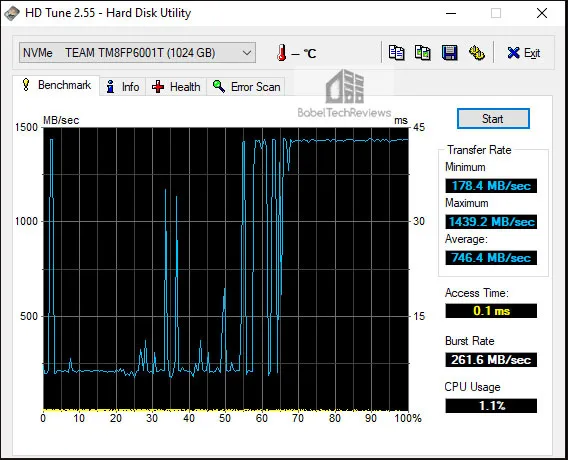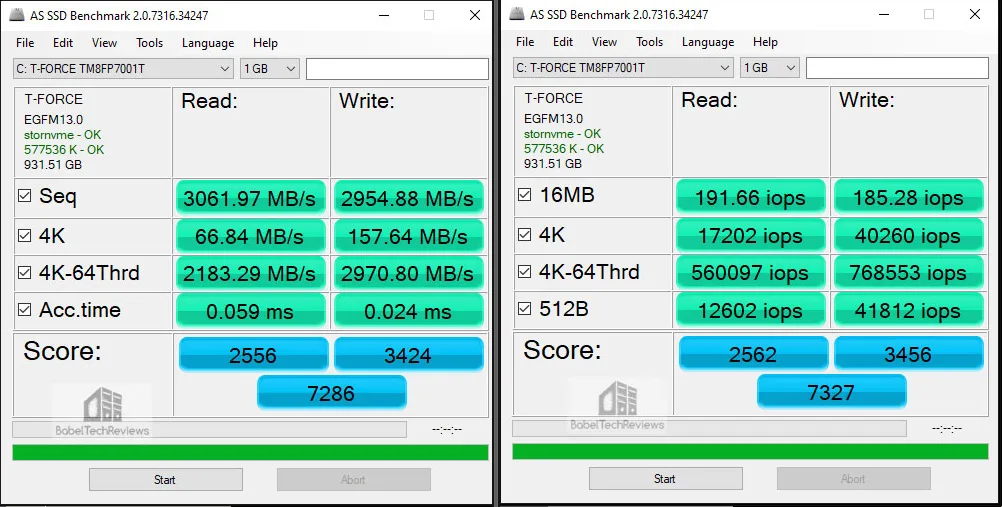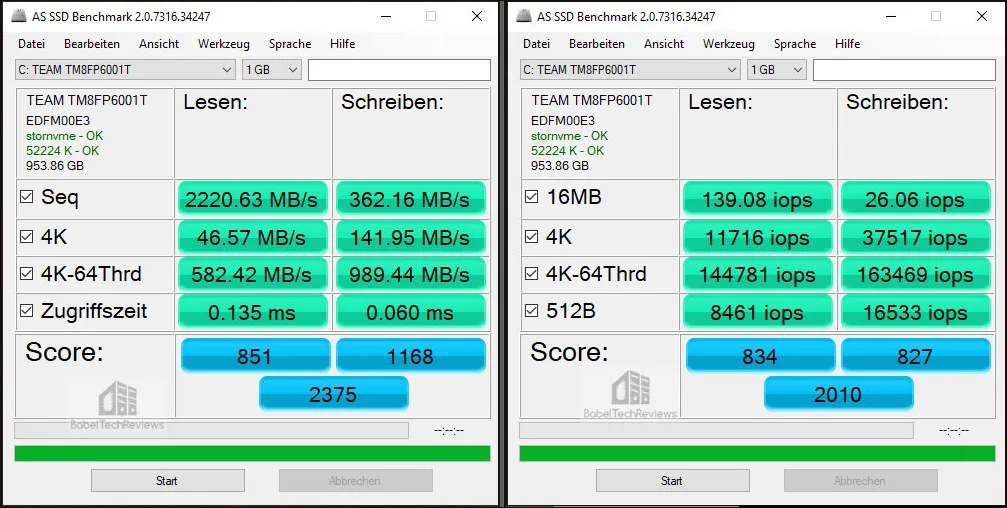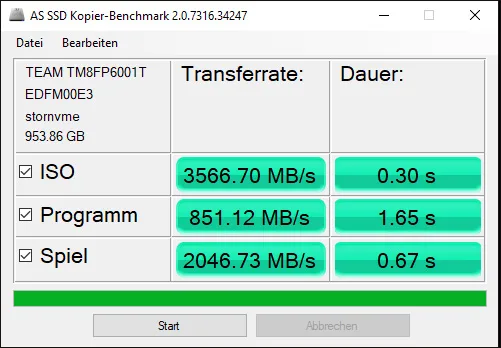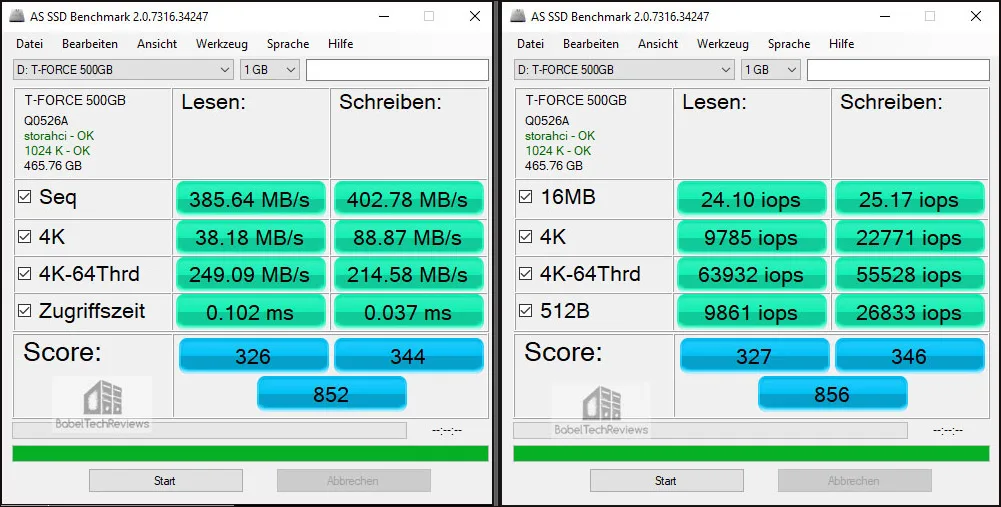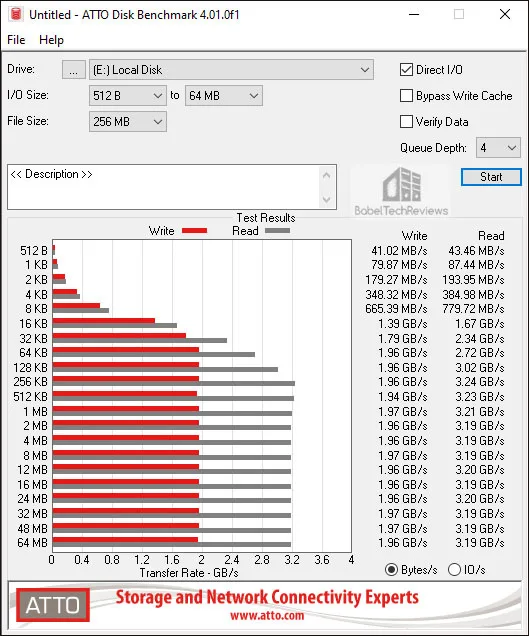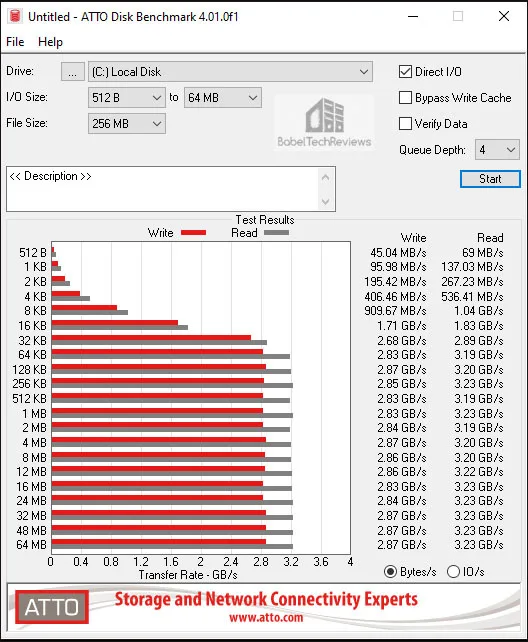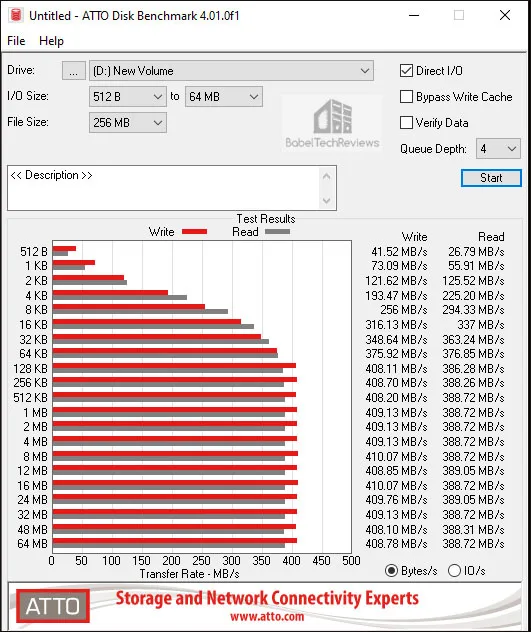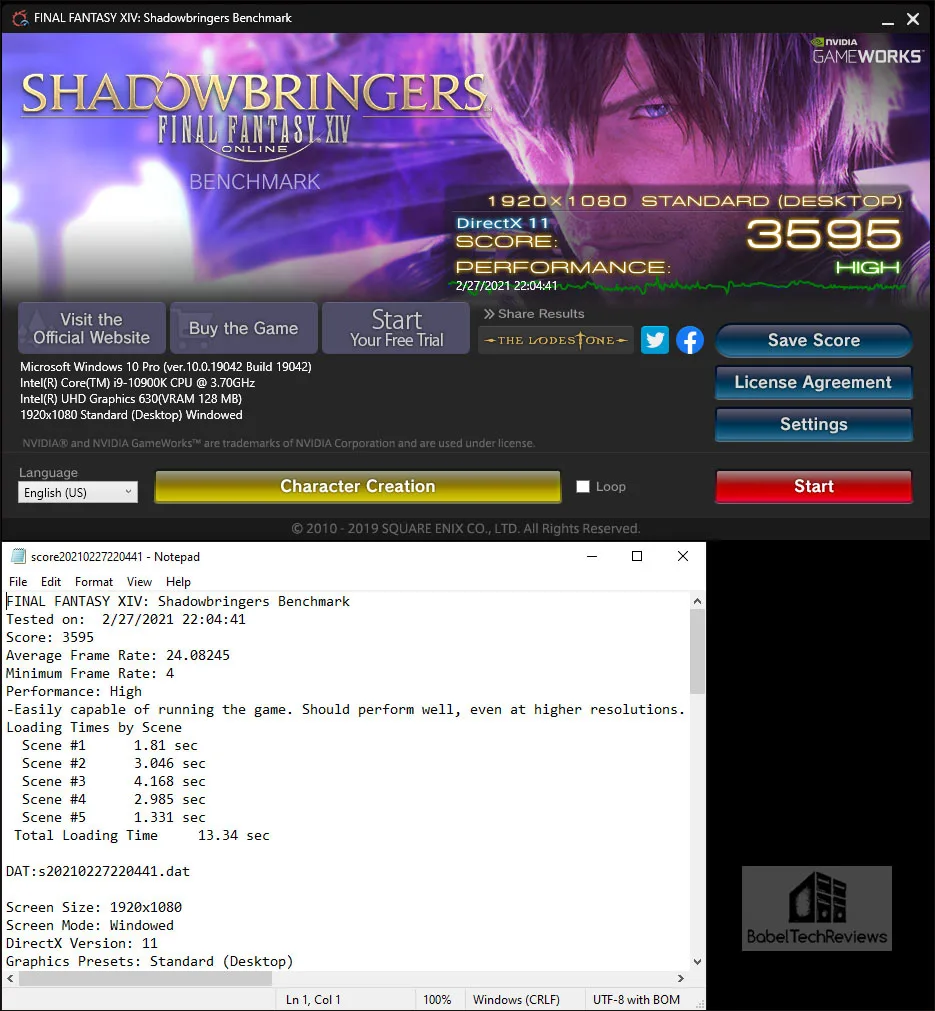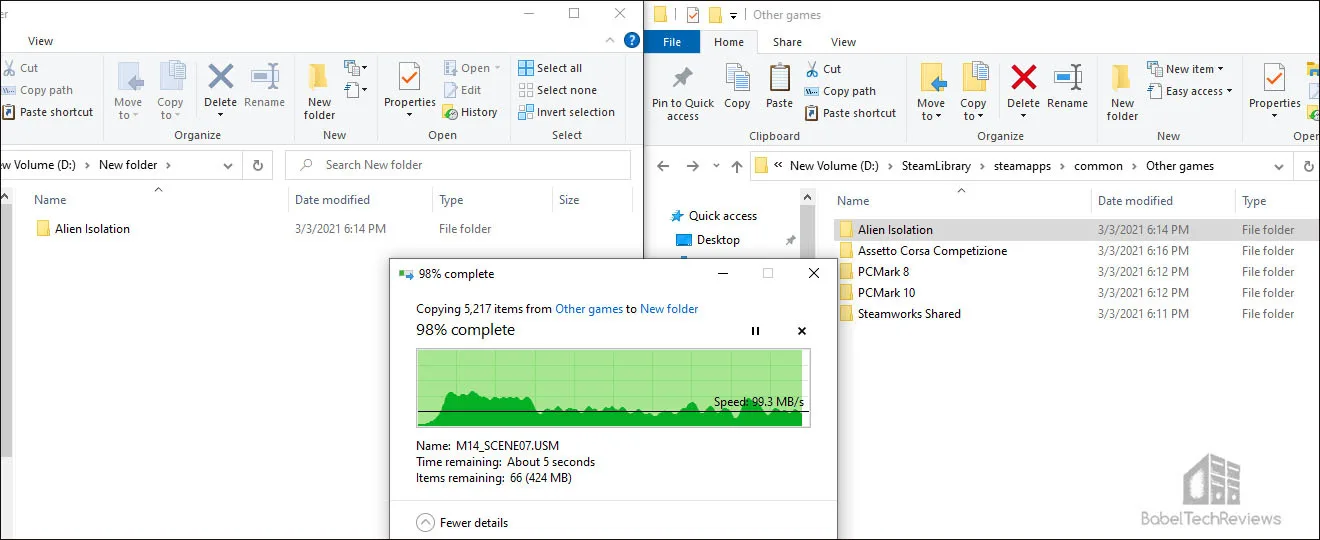The T-FORCE CARDEA C440 Gen 4 x4 PCIe NVMe 1TB SSD Review – 5GB/s using a Z490 Intel Motherboard with limited Bandwidth
The T-FORCE CARDEA Ceramic C440 Gen 4 x4 PCIe SSD (Solid State Drive) is a fast drive with Read/Write specs of 5000MB/s Read / 4400MB/s Write for the 1TB capacity. Although its specifications indicate that it is faster than most PCIe SSDs and significantly faster than any SATA III-based SSD, we want to see if this speed increase will make a practical difference for gamers.
Our review sample came directly from TeamGroup and we will focus on the C440’s performance by comparing it with three other SSDs. We are not really sure why TeamGroup sent it to us because the fastest Intel platform Z490 is a PCIe Gen3 motherboard that only supports speeds of 3400MB/s Read / 3000MB/s Write unlike the Ryzen 5000 series platform which can handle double the Intel PCIe bandwidth.
We have six SSDs (Solid State Drives) in BTR’s flagship i9-10900K PC with more than 6TB of total storage for games, and yet we always need more capacity. Using a mechanical 7200 rpm HDD or a Solid State Hard Drive (SSHD) is out of the question because of how slowly they load games and levels compared to SSDs.
BTR uses two 1TB TeamGroup MP33 NVMe PCIe SSDs – one for AMD and one for NVIDIA. Primary storage for our 50-plus PC games and 25-plus VR games are provided by two enterprise SATA III SSDs: a 1.92TB SanDisk SSD and a 2TB Micron 1100 SSD. In addition, we also use a T-FORCE Vulcan SATA III 500GB SSD and a 1TB TeamGroup SATA III GX2 for additional storage. The very fastest SATA III SSDs generally max out around or below 560/500MB/s while the PCIe NVMe drives are much faster.
We have already benchmarked HDDs and SSHDs previously, and they are painfully slow in comparison to any SSD. So this time, we are just going to concentrate on our three fastest PCIe NVMe drives – the 1TB CARDEA Ceramic C440, the CARDEA Liquid 512GB SSD, and the 1TB MP33 SSD – as well as our fastest SATA SSD, the T-FORCE Vulcan 500GB drive.
The T-FORCE Vulcan 500GB SATA III SSD can be found for $58.99 and the 1TB version is $105.99; the Liquid CARDEA NVMe2 512GB drive is $82.99, but the 1TB version is $134.99; and the PCIe Team Group MP33 1TBB SSD is $91.99. The C440 comes in just two capacities – 1TB at $189.99 and 2TB at $364.99. However, the CARDEA Ceramic C440 drive is currently discounted to $166.99 at Amazon, so you can see that high speed PCIe Gen 4 x4 SSDs are priced at a premium. So let’s see if the C440 it is worth its price premium – even on an Intel Z490 motherboard.
BTR’s test setup uses Windows 10 64-bit featuring an Intel Core i9-10900K overclocked to 5.1/5.0GHz for all cores as set in the EVGA Z490 FTW motherboard’s BIOS, and 16 GB of T-FORCE XTREEM DDR4 at 3866MHz. The settings and hardware are identical except for the four drives being tested, and the graphics are powered by Intel’s integrated CPU graphics. We tested the CARDEA Ceramic C440 using no PCIe drives attached, but the bandwidth the Z490 motherboard provides is the same whether we have no other drives connected or if we use our video card, a PCI soundcard, and 5 other SSDs.
We benchmark with all of our drives at less than 80% capacity, and in addition, all of the drives have been in use for months except for the CARDEA Ceramic C440 which has been “dirtied” using IOmeter as well as cloned from the TeamGroup MP33 SSD, so our benchmarking tends to give more real world performance results over using brand new drives. Here are the features and specifications of the T-FORCE CARDEA Ceramic C440 SSD taken directly from TeamGroup’s website.
FEATURES
- Unleash the ultimate power
- Beautiful and thin as a snowflake
- Top specification that breaks through the limit
- Aerospace ceramic material for better heat dissipation
- Trustworthy smart management technology
- Taiwan Utility Patent (number: M595313)
- Chinese Utility Patent (number: CN 210984280 U)
- 5 year limited warranty
Specifications
The specifications are also found on the TeamGroup website. 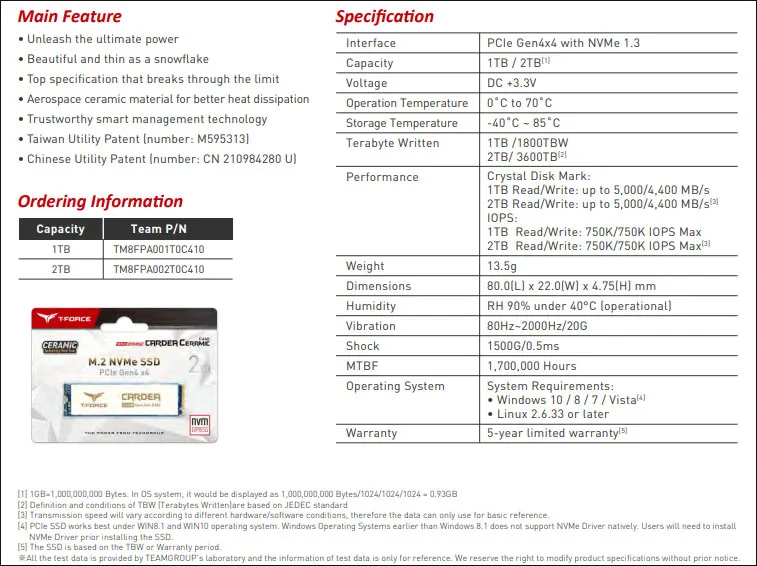
The key highlights are that the CARDEA Ceramic C440 Gen 4 x4 PCIe NVMe 1.3 SSD is fast, durable, uses little power, uses ceramic cooling technology, and is backed by TeamGroup’s 5-year warranty. Above all else, it is a very good looking SSD that would look incredible in an all-white build (but we think it also looks great in an all-black build).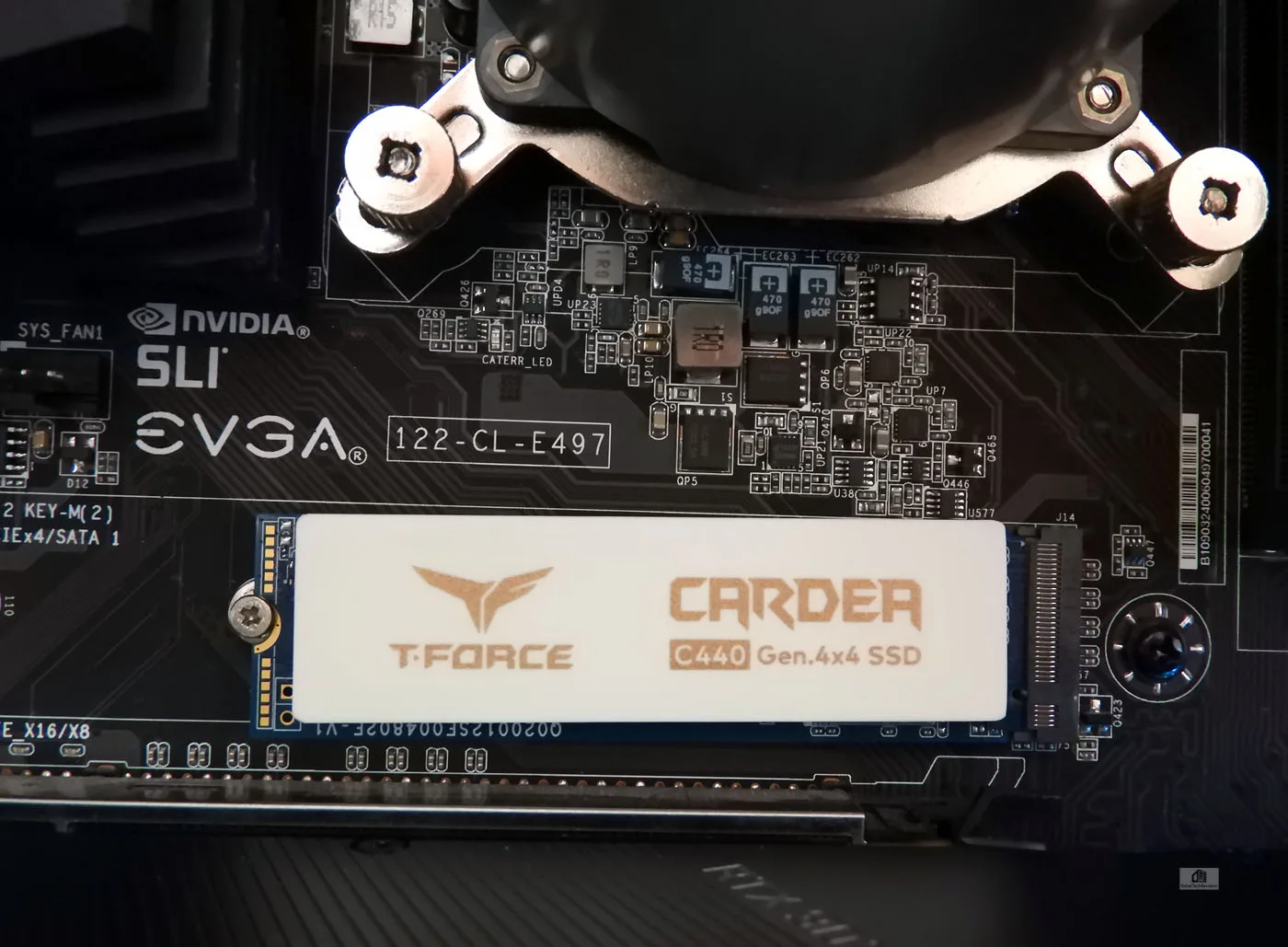
Next we unbox the CARDEA Ceramic C440 SSD and take a much closer look at it, including without its heatsink.
Unboxing and a Closer Look
The T-FORCE CARDEA Ceramic C440 1TB PCIe SSD arrives as a module that will fit most motherboards that support 2280 (W:22mm x L:80mm) PCIe M.2 drives. 
The CARDEA Ceramic C440 is a PCIe Gen 4 x4 SSD. As befits most SSDs, it comes in a blister pack that gives some details and highlights T-FORCE’s new 5-year SSD warranty. Emphasis is placed on the super-slim white ceramic heat sink which will provide significant cooling improvement over a bare drive.
The other side of the pack gives some specifications that show it is certainly fast for a NVMe PCIe SSD. The CARDEA Ceramic C440 specs up to ten times faster than many SATA III based SSDs with Read speeds up to 5000MB/s and Write speeds up to 4400MB/s.
The Team Group CARDEA Ceramic C440 PCIe 1TB SSD modules are set onto a blue PCB with a very thin ceramic heatsink that measures approximately 5mm total width in thickness. A sticker warns that the 5 year warranty will be void if it is removed. 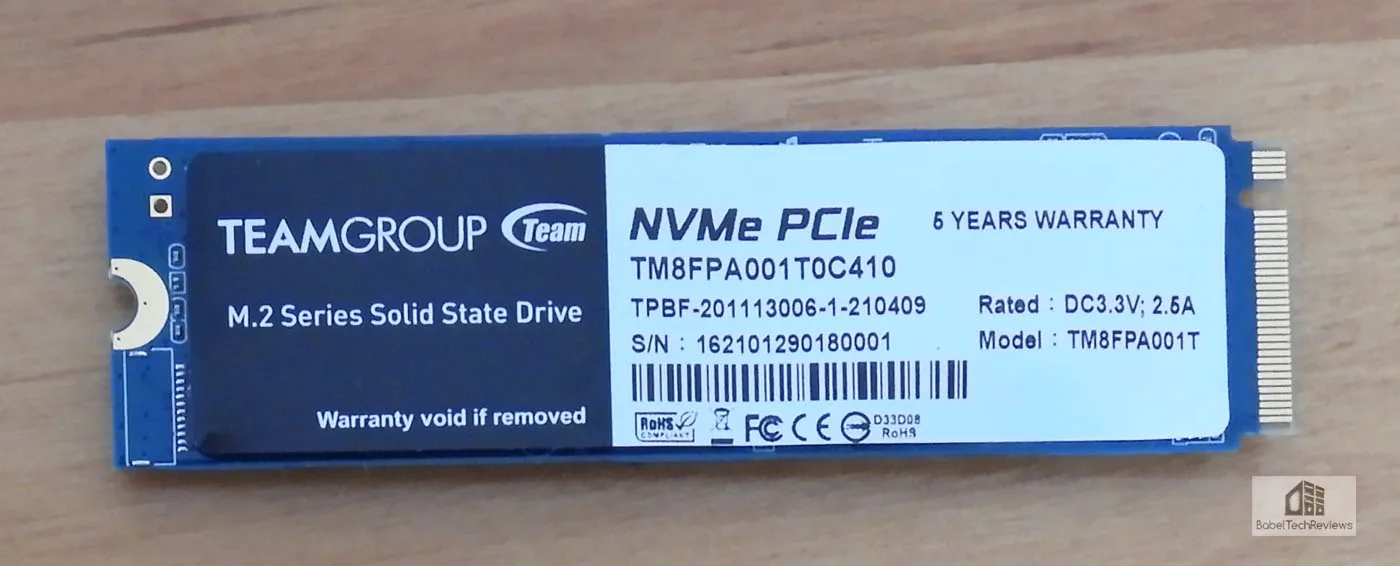
So we removed it anyway and you can see the controller and the memory modules. The C440 is powered by a Phison PS5016-E16 NVMe 8-channel controller PCIe 4.0 x4 NVMe 1.3 SSD controller using dual Arm Cortex R5 processors together with other processors. It’s buffer appears to use SKHynix DDR4 DRAM chips and Kioxia TLC for the NAND flash memory totaling 1TB.
3D NAND is used and the C440 supports S.M.A.R.T. function, garbage collection (GC), TRIM, LDPC error correction, and Data Protection for a long life, hopefully well-beyond TeamGroup’s 5-year warranty.
Make sure to use a magnetic screwdriver for installation. After installing the CARDEA Ceramic C440, the user may need to format it before using it. If you are planning to clone it, make sure the source and the target disks are both GUID or convert one of them so they are the same. It appears that the C440 requires using UEFI, not legacy, setting in the BIOS.
The white ceramic heatsink helps keep temperatures lower by transferring the heat to itself and then radiating heat better than the individual modules can. However, when we first installed it, we were totally shocked by the temperatures we were reading. Using an infrared thermometer we saw the ceramic heatsink temperatures reach temperatures above 75C! Well, evidently the adhesive wasn’t properly applied when we received it, and the heatsink even fell off of the SSD. We stuck it back on while it was still hot and it stuck, and temperatures returned to normal peaking in the very hottest area of the ceramic heatsink at ~60C which is acceptable.
We would definitely not recommend running the CARDEA Ceramic C440 without a heatsink since temperatures above 70C are too hot, and an SSD’s speed will throttle. We think that the CARDEA Ceramic C440 makes better use of its Ceramic heatsink than the CARDEA Liquid SSD does of its liquid filled chamber which appears to be primarily built for show. We also think the white ceramic heatsink looks awesome in either an all-white or even in an all-black PC.
Lets look at our test configuration next.
Test Configuration – Hardware
- Intel Core i9-10900K (HyperThreading and Turbo boost is locked on to 5.1/5.0GHz for all eight cores. Comet Lake DX11 CPU graphics.
- EVGA Z490 FTW motherboard (Intel Z390 chipset, latest BIOS with Resizable BAR enabled, PCIe 3.0/3.1/3.1 – USB 3.0 Type-C specification, CrossFire/SLI 8x+8x)
- T-FORCE XTREEM 16GB DDR4 (2x8GB, dual channel at 3866MHz), supplied by Team Group
- T-FORCE CARDEA Ceramic C440 1TB PCIe Gen 4 x4 NVMe SSD
- T-FORCE Liquid CARDEA 512GB PCIe Gen 3 x4 NVMe SSD
- Team Group MP33 1TB NVMe Gen 3 x4 PCIe SSD
- T-FORCE Vulcan 500GB SATA III SSD
- ANTEC HCG1000 Extreme, 1000W gold power supply unit
- DEEPCOOL Castle 360EX AIO 360mm liquid CPU cooler
- Phanteks Eclipse P400 ATX mid-tower (plus 1 Noctua 140mm fan)
- BenQ EW3270U 32? 4K HDR 60Hz FreeSync monitor
Test Configuration – Software
- Intel’s latest drivers. v27.20.100.9316
- Gaming results show loading time in seconds and lower is better
- Windows 10 64-bit Pro edition; latest updates v10.01904 Build 19042.
- Latest DirectX
- All benchmarking programs are updated to their latest versions
- IOmeter
- HD Tach
- HD Tune
- AS SSD
- ATTO
- Crystal DiskMark
- S.M.A.R.T. Tool (TeamGroup)
PC Game & Level Loading Suite
- World of Warcraft (PCMark 8)
- Battlefield 3 (PCMark 8)
- Final Fantasy XV: Shadowbringers benchmark – loading times of five levels each
Synthetic Benching Suites
- SiSoft Sandra 2020
- AIDA64
- PCMark 8
- PCMark 10
- SPECworkstation3 (3.0.4) Benchmarks
- Anvil’s Storage Utilities
- TxBENCH
Let’s head to our benching results.
Benchmarking the CARDEA Ceramic SSD
Benchmarking SSDs are not an exact science as there is variability between runs, and different benchmarks may show different results depending on how they run their tests and how up-to-date the benchmarks are. However, by using enough real world and synthetic tests, it may be possible to get a good idea of relative performance across all four tested drives. For benchmark results, the drives are generally listed in the following order on the charts:
- T-FORCE CARDEA Ceramic C440 1TB PCIe Gen 4 x4 NVMe SSD
- T-FORCE Liquid CARDEA 512GB PCIe Gen 3 x4 NVMe SSD
- Team Group MP33 1TB NVMe Gen 3 x4 PCIe SSD
- T-FORCE Vulcan 500GB SATA III SSD
We did not set up Windows on the Vulcan SSD, so not all of the benchmarks could be run on it. All of the drives will have their results summarized in multiple charts.
Let’s start first with TeamGroup’s own S.M.A.R.T. utility to get some information on each SSD.
S.M.A.R.T.
This TeamGroup S.M.A.R.T. utility is one we recently discovered that gives more information in one place than many other utilities. First is the system and disk information for the CARDEA Ceramic C440.
S.M.A.R.T. also tests the drive with two sets of tests. First up, the performance tests in MB/s for the T-FORCE CARDEA Ceramic C440.
Next the performance dual test results given in IOPS for the CARDEA Ceramic C440.
Finally, S.M.A.R.T. measures latency for the CARDEA Ceramic C440.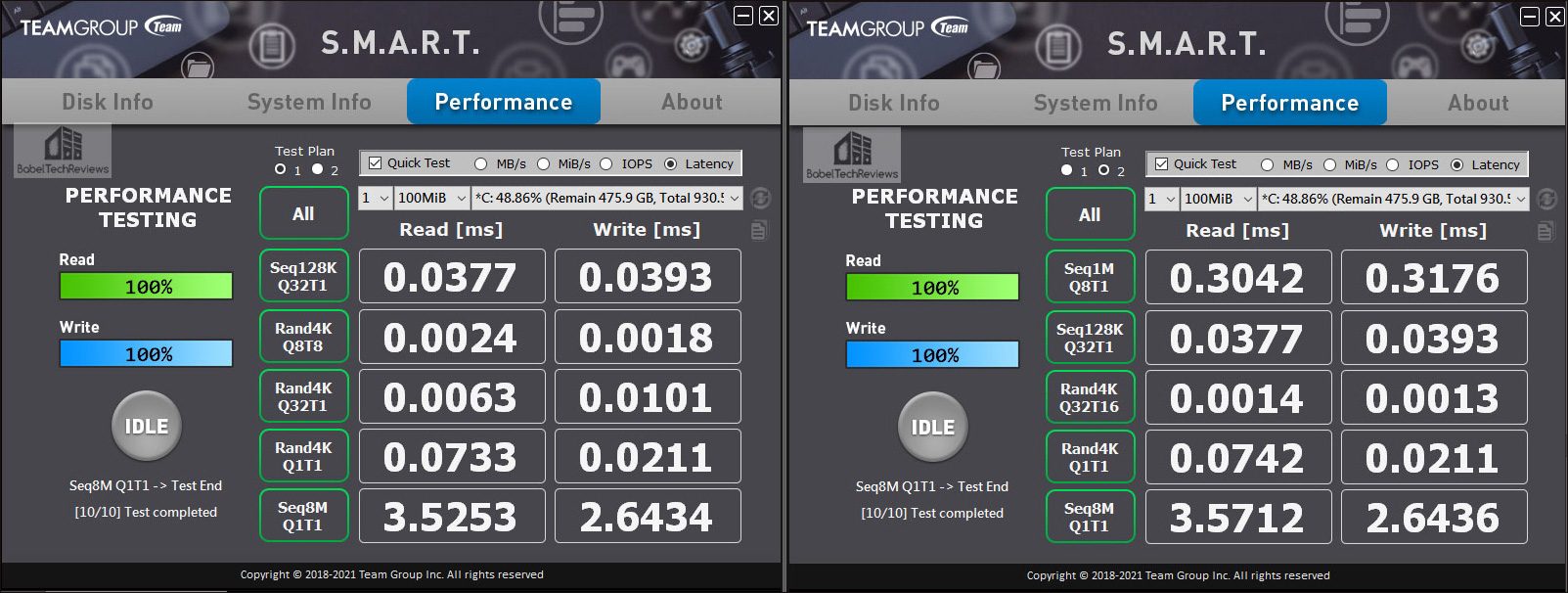
Next we look at the performance tests in MB/s for the CARDEA Liquid SSD.
Next we look at the dual latency tests for the CARDEA Liquid SSD.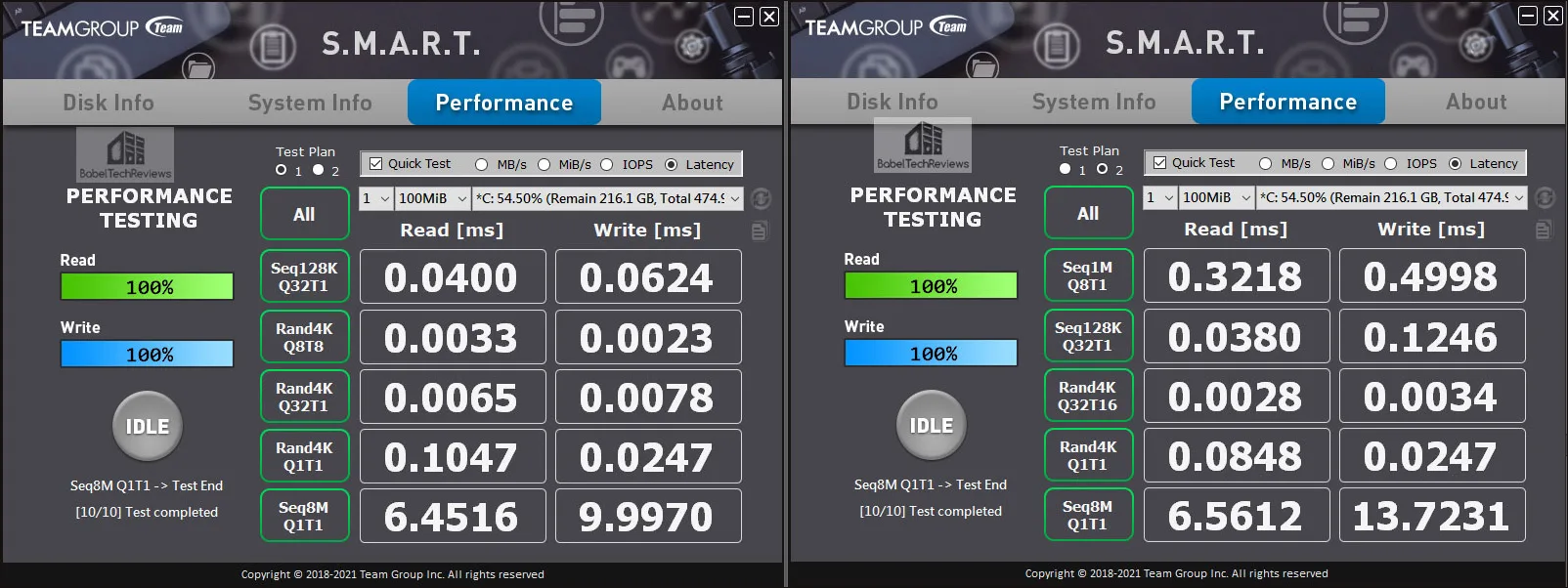
Next we look at the performance tests in MB/s for the TeamGroup MP33 SSD.
Next we look at the dual latency tests for the MP33 SSD. 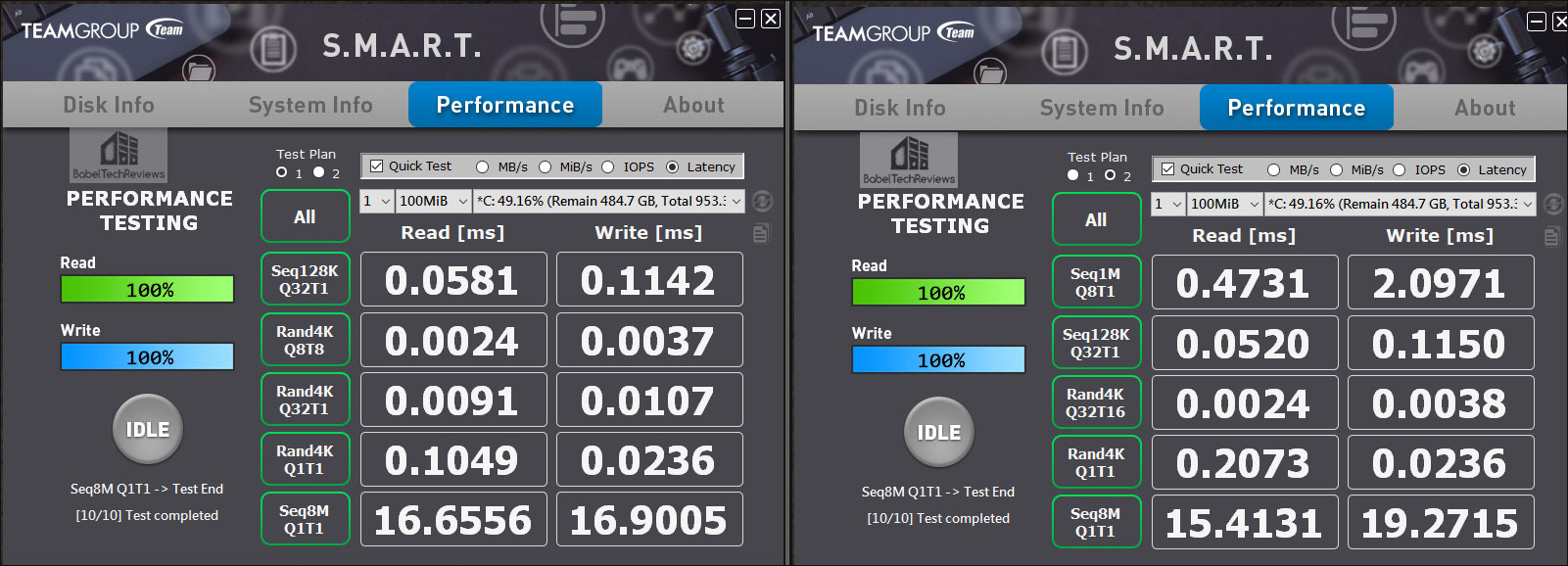
Next we look at the performance tests in MB/s for the Vulcan SATA III SSD.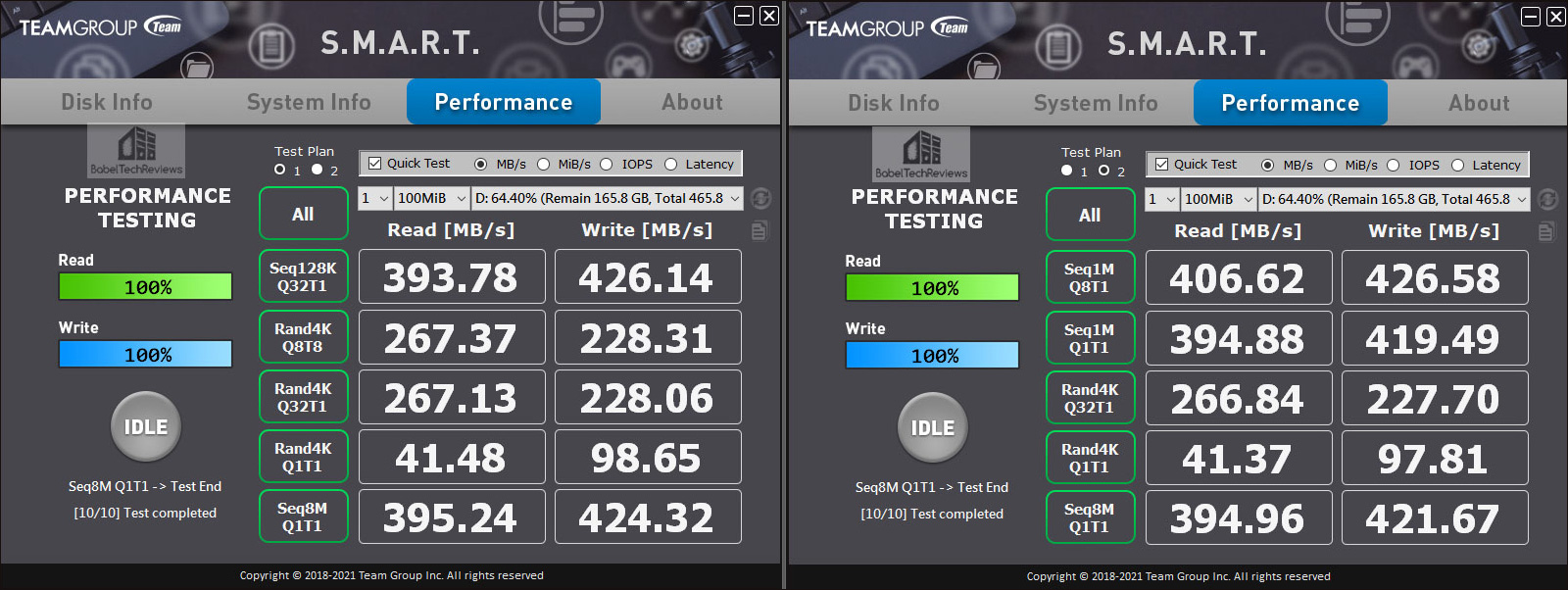
Finally, we look at the dual latency tests for the Vulcan SSD.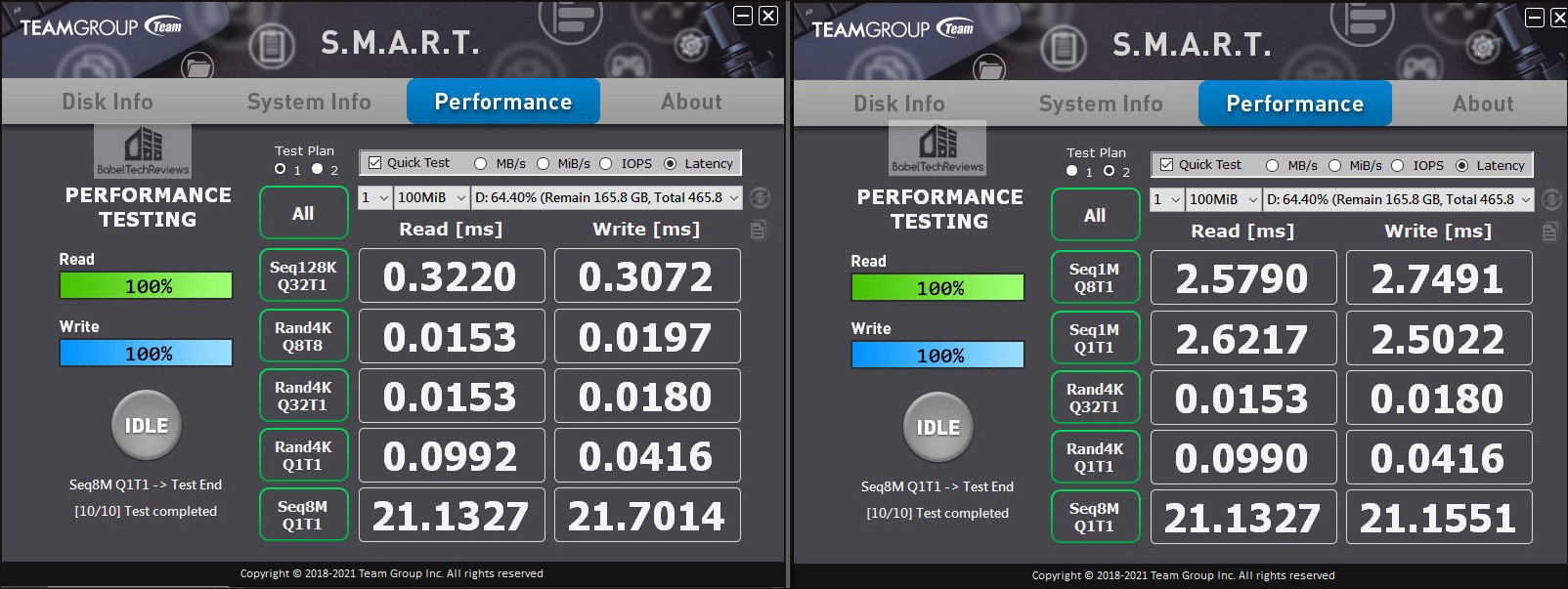
S.M.A.R.T. clearly shows the CARDEA Ceramic C440 is the fastest SSD, followed by the CARDEA Liquid, then the TeamGroup MP33 SSD, and in last place, the SATA III Vulcan SSD. TeamGroup’s S.M.A.R.T. is a good place to start, so let’s see what other synthetic and real world tests show.
Let’s start with PCMark 10.
PCMark 10
UL (formerly Futuremark) has been a developer and publisher of PC benchmark applications for nearly two decades. Although PCMark benches are synthetic tests, they provide a good measure of system performance.
PCMark 10 was primarily developed for Windows 10 and it builds upon the PCMark 8 platform for a package of vendor-neutral home and office benchmarks. Unfortunately, in comparison to PCMark 8, PCMark 10 is missing key elements including detailed storage testing, and it is not possible to test the Vulcan SATA SSD as an attached drive as with the earlier suite.
We use both PCMark 10’s Express and Extended settings. The Express benchmark suite is best suited for office tasks while the Extended benchmarks are for power users
To properly compare the PCMark 10 scores, look at the detailed results that you want to compare. All of the NVMe drives results are presented as screenshots. Open the images in separate tabs for easy individual test result comparisons.
Express benchmarks
First up is the CARDEA Ceramic NVMe Express score with 5562. 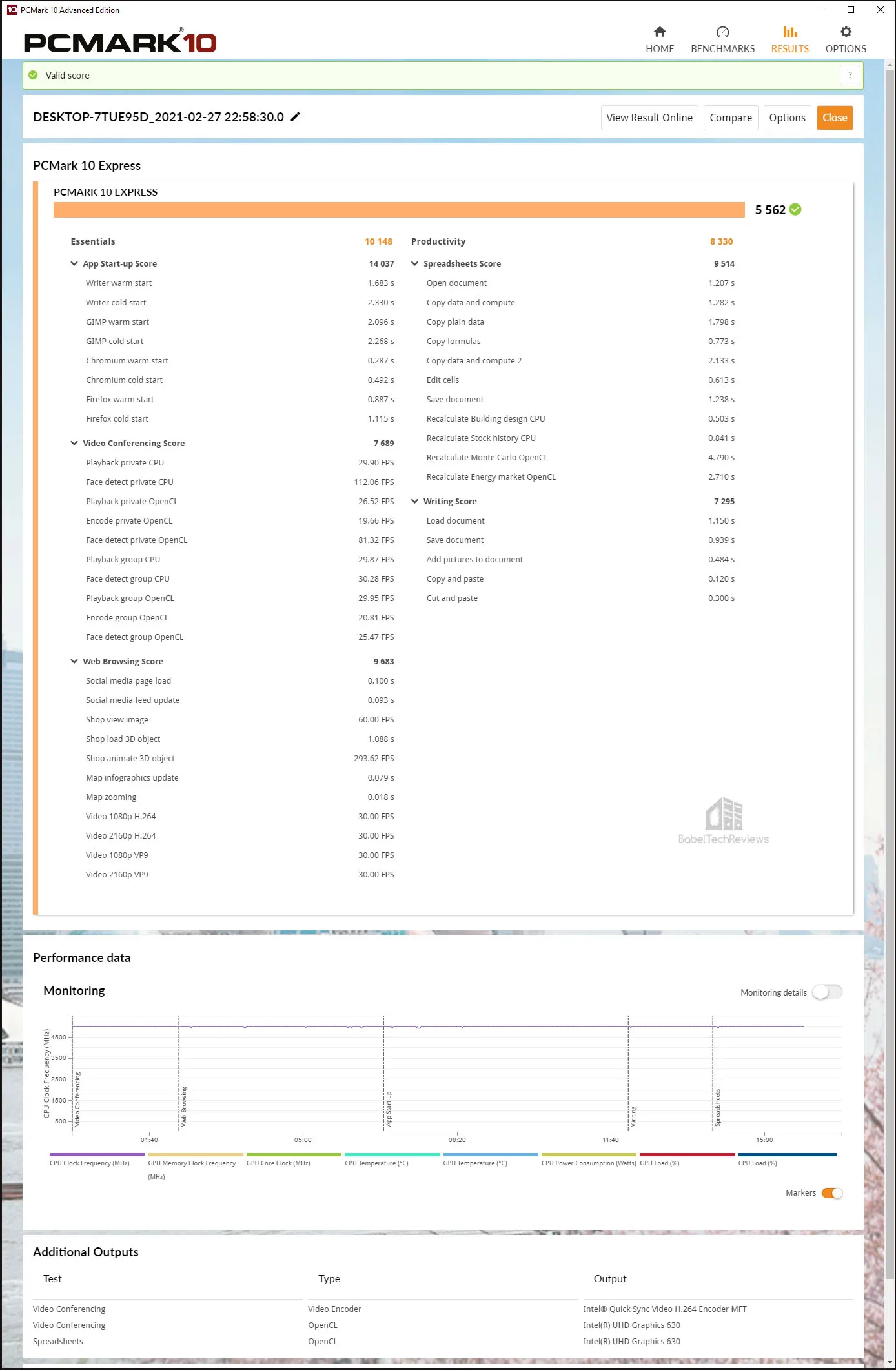 Here are the Liquid CARDEA Express results with 5475
Here are the Liquid CARDEA Express results with 5475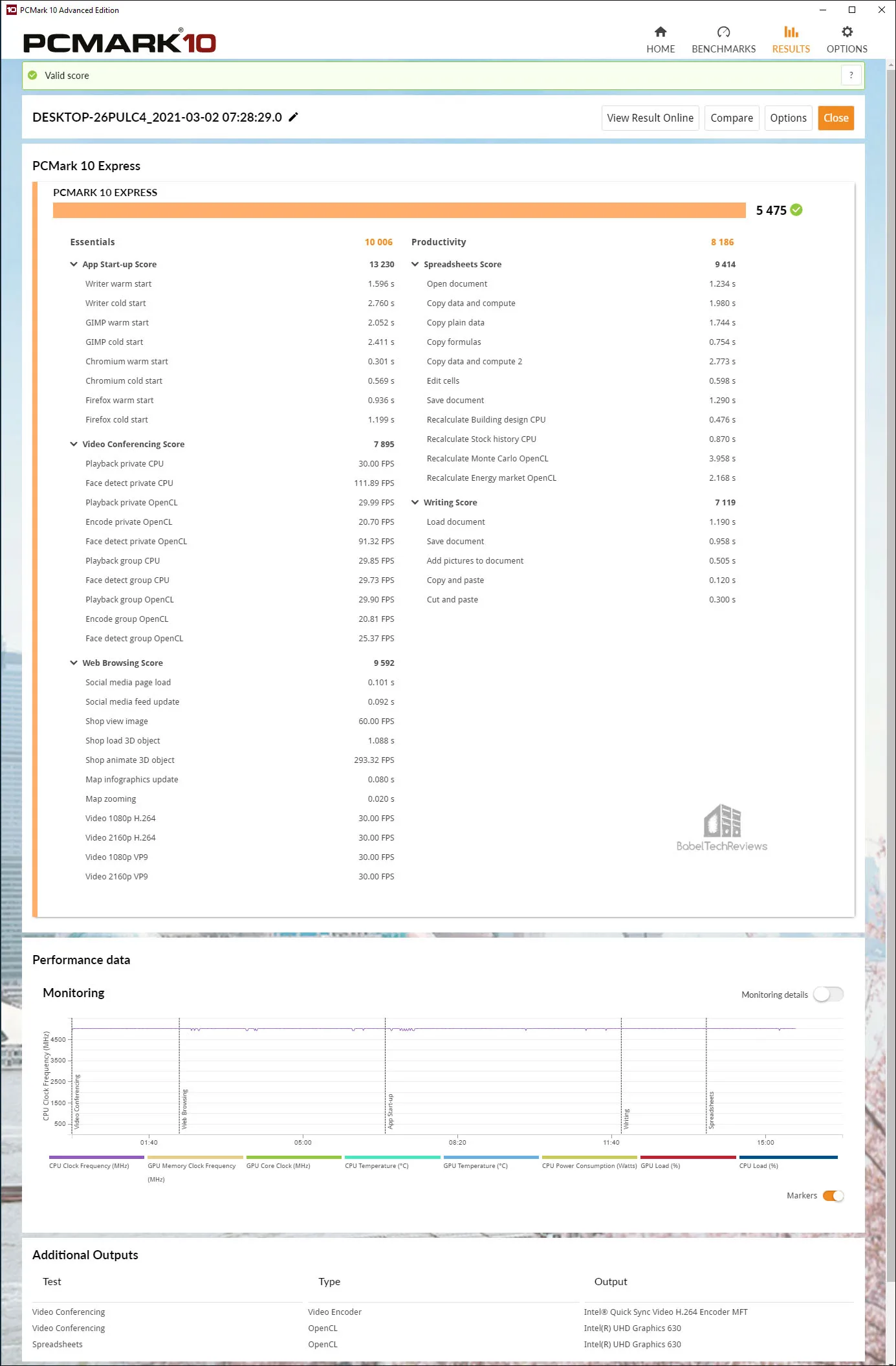
Here are the Team Group MP33 NVM2 PCIe 1TB SSD express scores 5428
Extended benchmarks
First up is the CARDEA Ceramic Extended score with 3758.
Here is the CARDEA Liquid Extended score with 3741.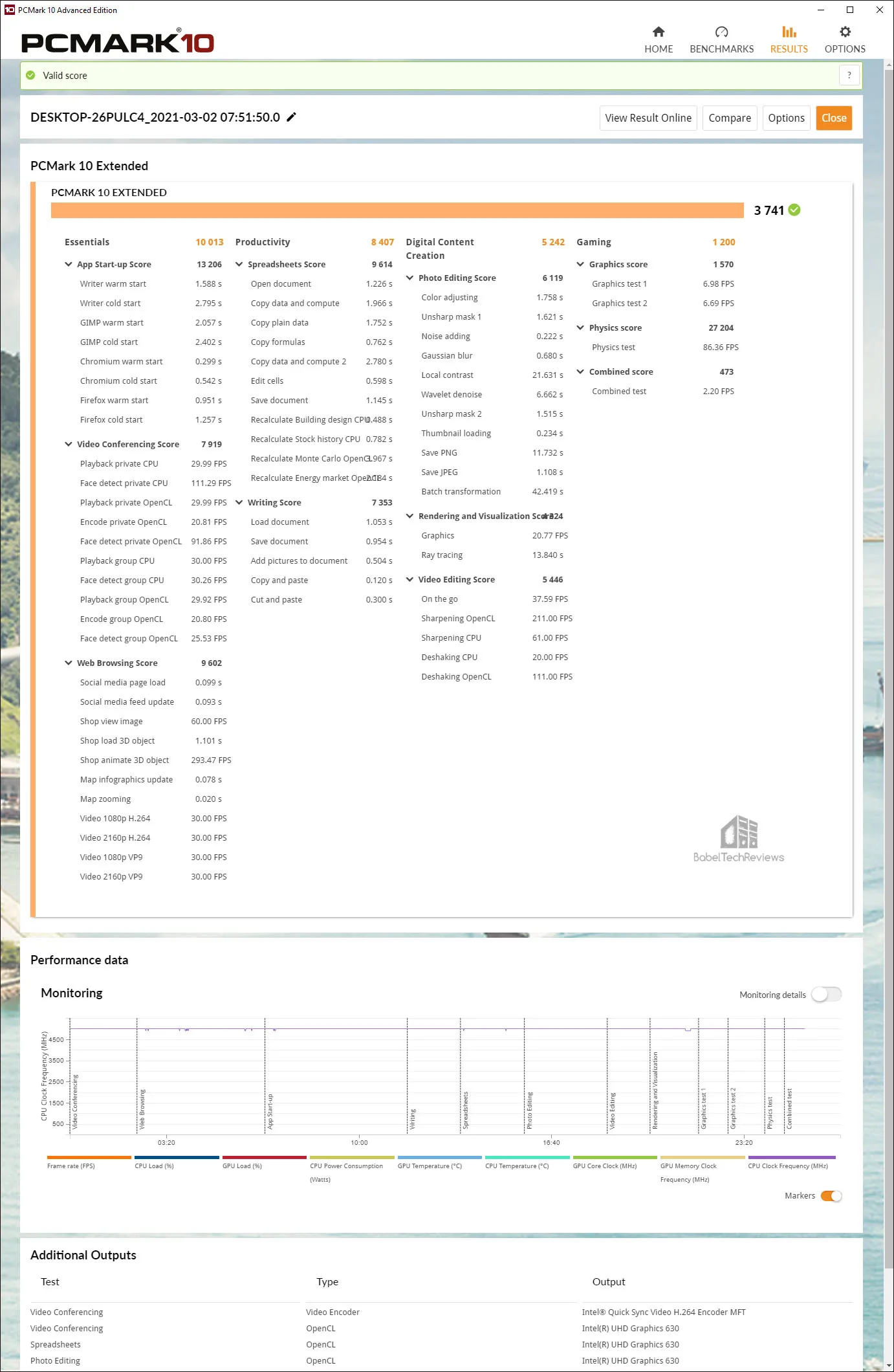
The Team Group MP33 M.2 PCIe 1TB SSD scores 3699 on the Extended benchmarks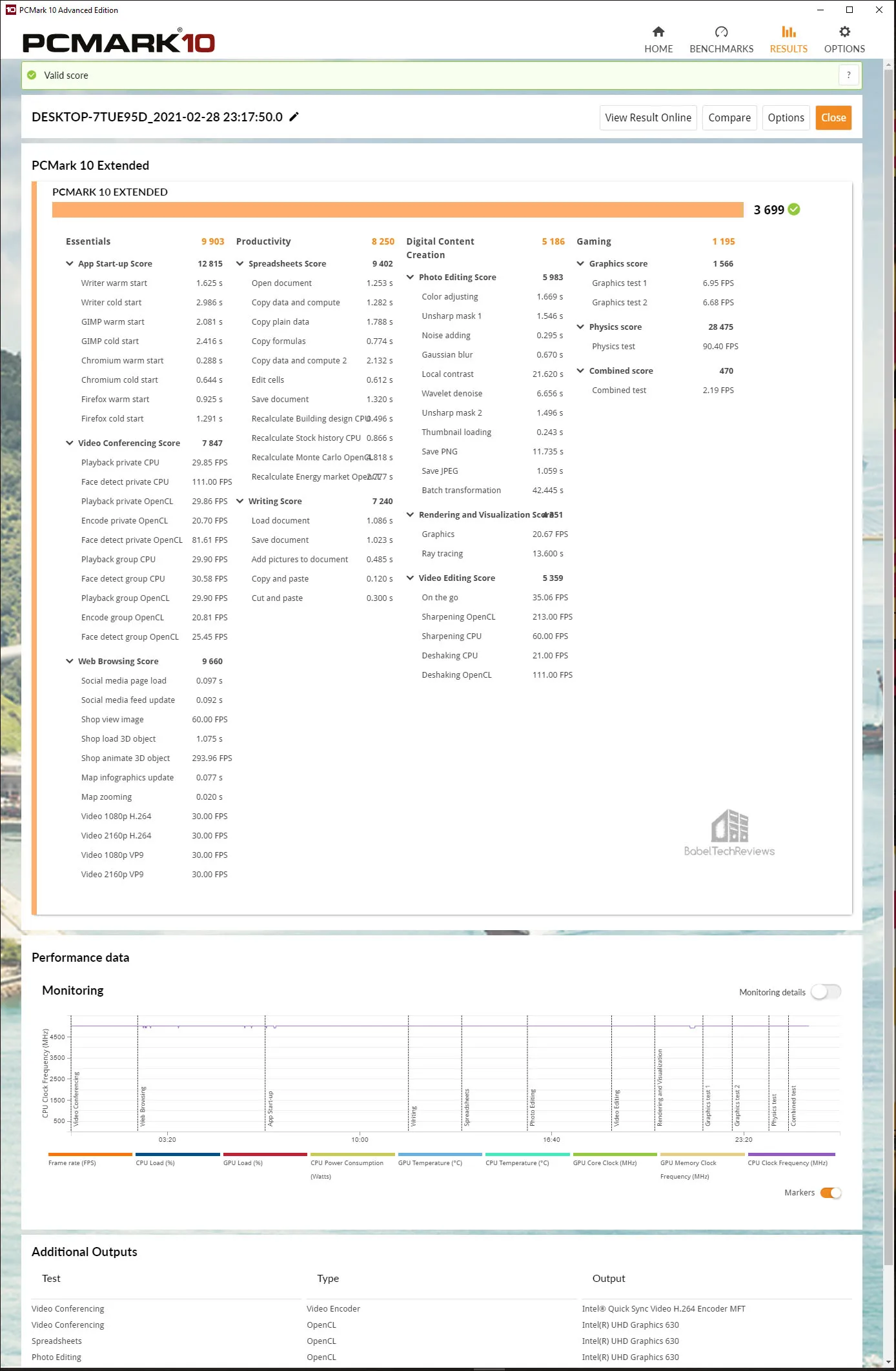
Here is the summary of the 3 drives that were tested, and the CARDEA Ceramic scores particularly well and leads the other SSDs.
Let’s check out PCMark 8 which uses better dedicated storage tests.
PCMARK 8
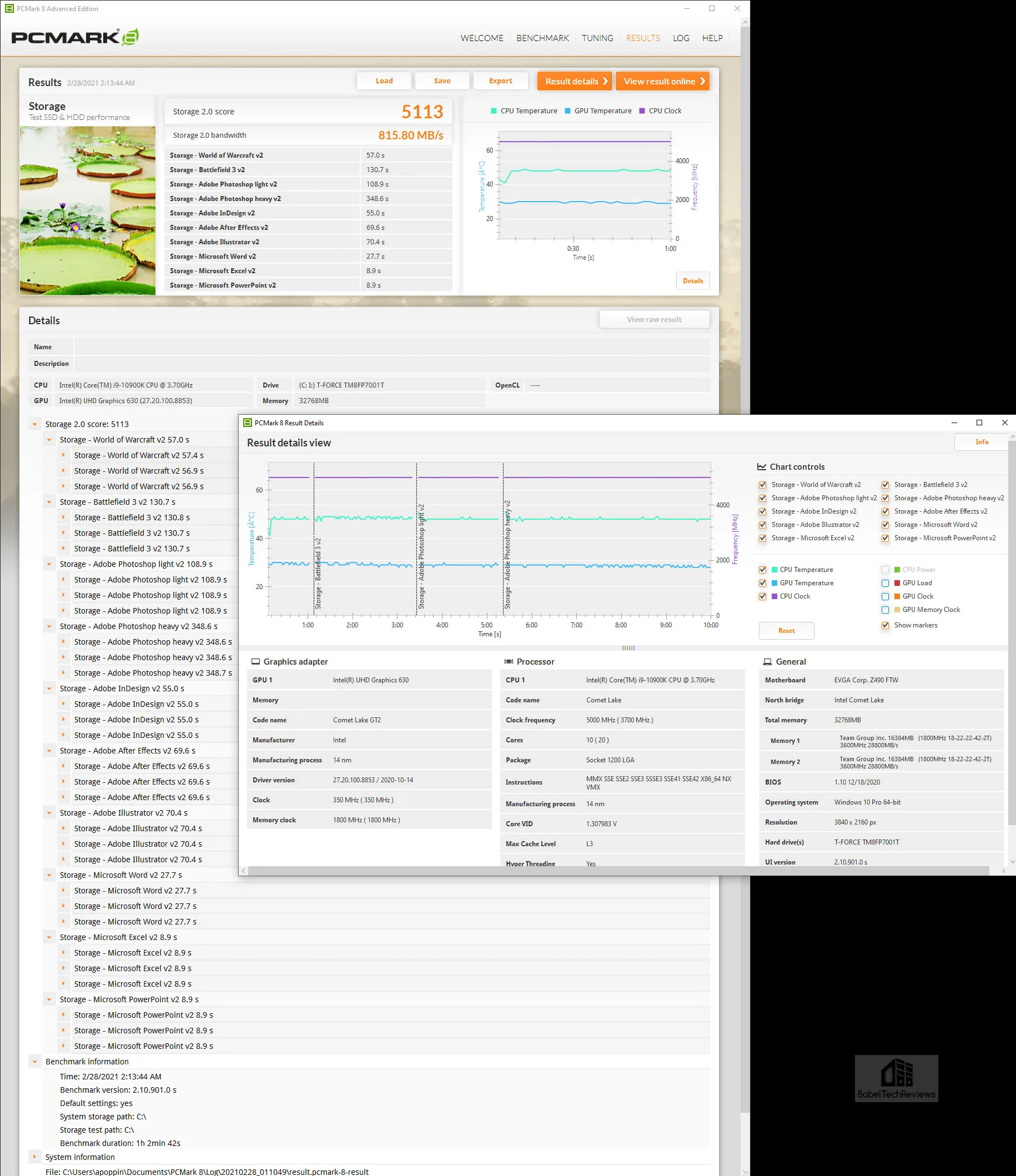

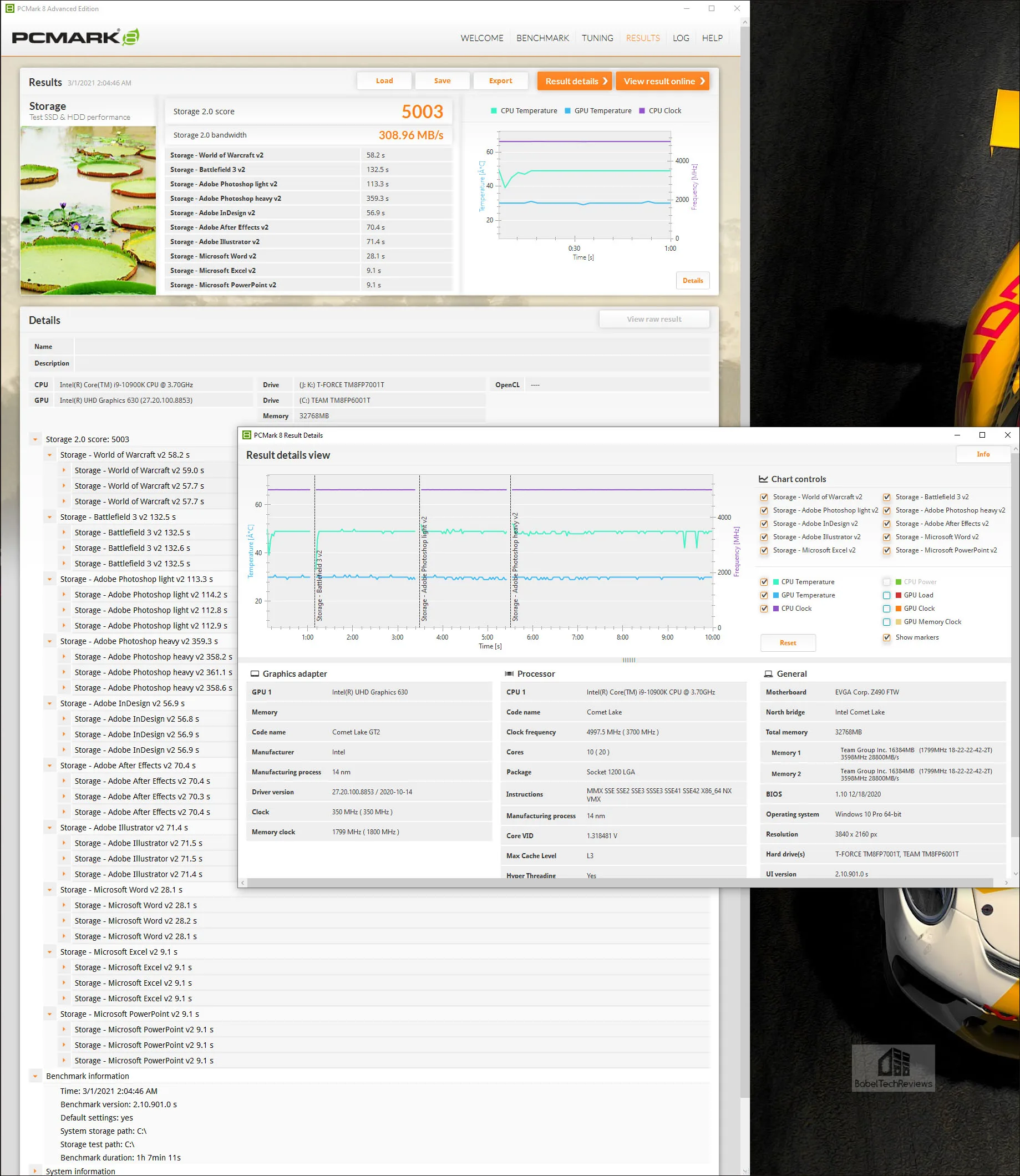
T-FORCE Vulcan 500GB SATA III SSD scores 4965 with a total Storage 2.0 Bandwidth of 250.30 MB/s. It took 58.1 seconds to load World of Warcraft and 133.5 seconds for Battlefield 3 to load.

SiSoft Sandra 2020/2021
To see exactly where drive performance results differ, there is no better tool than SiSoft’s Sandra 2020. Sandra (the System ANalyser, Diagnostic and Reporting Assistant) is a complete information & diagnostic utility in one package. It is able to provide all of the information about your hardware, software, and other devices for diagnosis and for benchmarking.AIDA64 v6.32
AIDA64 is the successor to Everest and it is an important industry tool for benchmarkers. AIDA64’s benchmark code is written in Assembly language, and they are well-optimized for AMD, Intel and VIA processors by utilizing the appropriate instruction set extensions. We use the Engineer’s version of AIDA64 courtesy of FinalWire. AIDA64 is free to to try and use for 30 days. We run the AIDA64 overall Disk Benchmark and the 4 individual Read tests for each drive, and we include the image for the tests and then summarize all of our drive results in a chart. These tests are very detailed, and since there are a lot of customization options available we run the default tests. We did not run the Read tests as they will destroy the data on the disks being tested.- The Linear Read test measure sequential performance by reading or writing all sectors without skipping any. It’s a linear view of the drives overall performance from its beginning to end.
- The Random Read test measures the random performance by reading variable-sized data blocks at random locations on the drive and they are combination of both speed and access times as its position changes before each new operation.
- The Buffered Read test measures the drive caching.
- The Access time tests are designed to measure the data access performance by reading 0.5 KB data blocks at random drive locations
SPECworkstation3 (3.0.4) Disk Benchmarks
All the SPECworkstation3 benchmarks are based on professional applications, most of which are in the CAD/CAM or media and entertainment fields. All of these benchmarks are free except for vendors of computer-related products and/or services.
The most comprehensive workstation benchmark is SPECworkstation3. It’s a free-standing benchmark which does not require ancillary software. It measures GPU, CPU, storage and all other major aspects of workstation performance based on actual applications and representative workloads. SPECworkstation Disk benchmarks are perhaps more demanding than the 3DMark tests and only WPCstorage was performed. It was not possible to run it on the Vulcan SSD since there is no operating system running on it.
We only tested disk-related SPEC workstation WPCstorage performance which includes multiple tests like 7-Zip, Maya, Handbrake, and Mozilla, and first up is the CARDEA Ceramic C440.
Here are our T-Force CARDEA Ceramic C440 SPECworkstation storage 3.0.4 raw scores.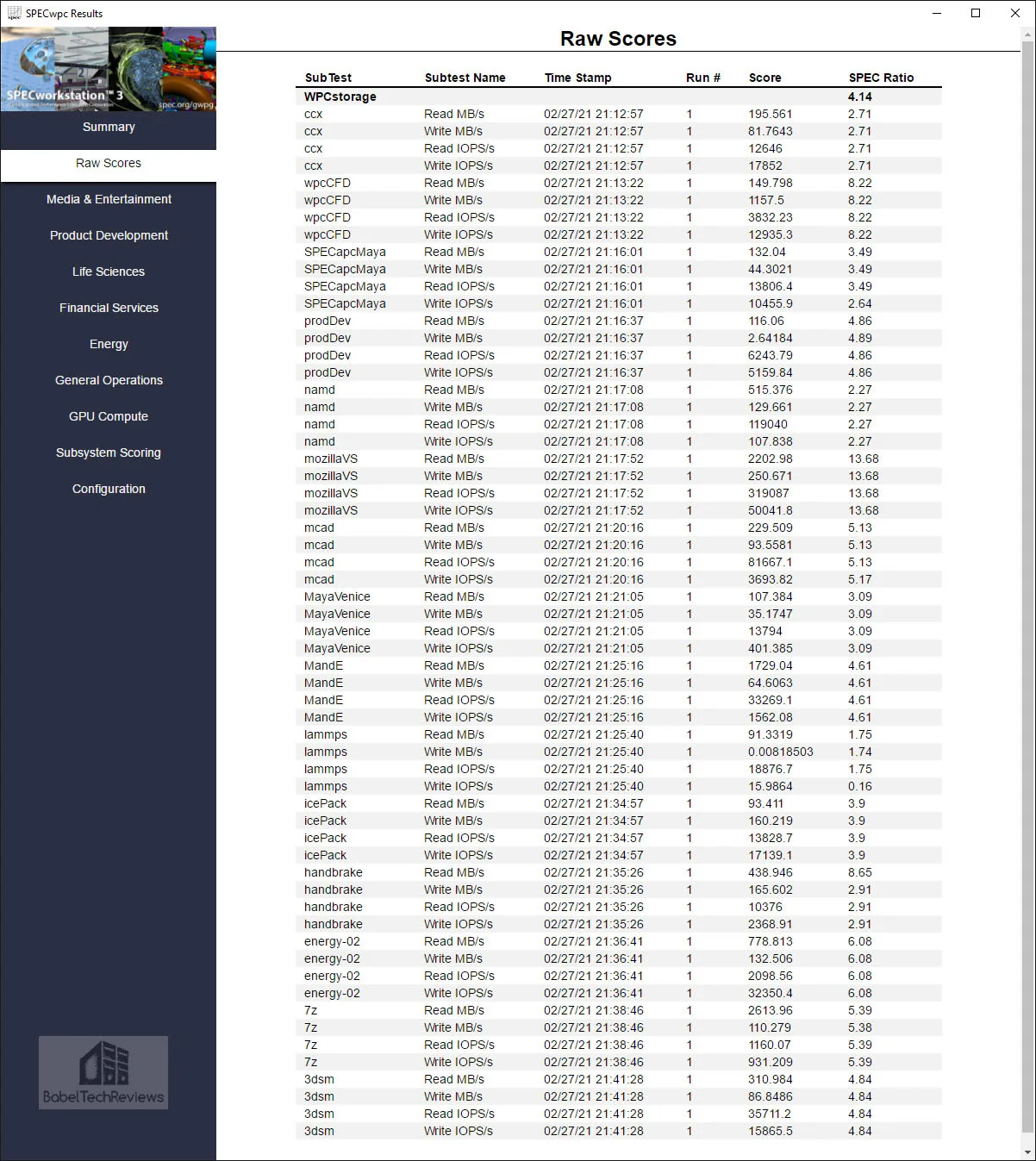
Next are the T-Force Liquid CARDEA results.
Lastly the TeamGroup MP33 NVMe SSD results.
The T-Force Vulcan SATA III SSD was not tested since we did not set up Windows on it. Here are the SPECworkstation3 results summarized in a chart along with two of the competing PCIe NVMe SSDs. Higher is better since the results are expressed as a score.
Using SPEC benchmarks, we see the Cardea Ceramic C440 is the fastest at SPEC workstation WPCstorage tests followed by the CARDEA Liquid and then by the MP33 SSD.
Anvil’s Storage Utilities
Anvil’s Storage Utilities is a tool designed to benchmark and evaluate the Read and Write performance of SSDs and HDDs. It gives overall bandwidth as well separate Read and Write scores, the response times, and IOPS capabilities.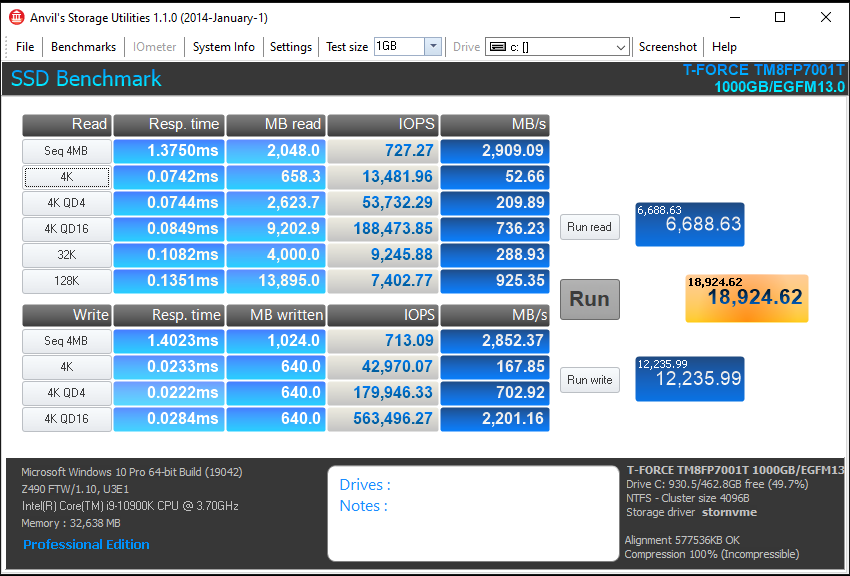

CrystalDiskMark 8.0.1
CrystalDiskMark is a HDD benchmark utility for your drives that measure sequential and random read/write speeds. Here are some key features of “CrystalDiskMark”:- Measure sequential reads/writes speed
- Measure random 512KB, 4KB, 4KB (Queue Depth=32) reads/writes speed
- Results given in IOPS or MB/s


 Here is the summary chart highlighting the most often quoted Read/Write performance data. Higher is better.
Here is the summary chart highlighting the most often quoted Read/Write performance data. Higher is better.
TxBENCH
TxBENCH is similar to CrystalDiskMark but with additional features including secure erase. According to the website, “It not only measures the performance of storage easily but also performs detailed speed measurements based on specified access patterns and long-period speed measurements. It also allows you to see each drive’s supported features, enabled features, and S.M.A.R.T. information.”
T-FORCE Liquid CARDEA 512GB PCIe Gen 3 x4 NVMe SSD is next.
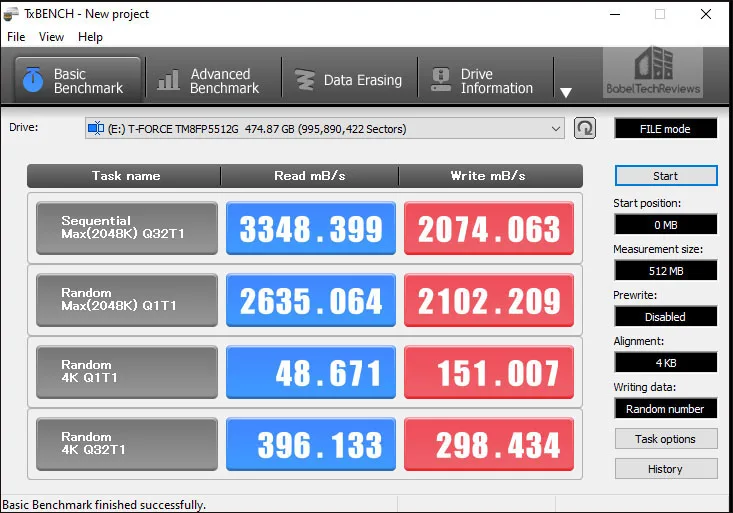 Team Group MP33 1TB NVMe Gen 3 x4 PCIe is below.
Team Group MP33 1TB NVMe Gen 3 x4 PCIe is below.
The T-FORCE Vulcan 500GB SATA III SSD is last.

HD Tune
This free standalone synthetic test is old and it doesn’t represent real world performance but it does test some important drive metrics. There is also a pay-for HD Tune Pro which is up-to-date and offers more functionality. We tried the Pro trial recently just to make sure the free version is still relevant. HD Tune has the following functions, and it measures the performance of:- Transfer Rate
- Access Time
- CPU Usage
- Burst Rate
- Random Access test
- Write benchmark
- Hard Disk Health
- S.M.A.R.T. Information (Self-Monitoring Analysis and Reporting Technology)
- Power On Time
- Error scan
- Temperature display
Next the Liquid CARDEA results.
Next we benchmark using AS SSD.
AS SSD
AS SSD is designed for Solid State Drives (SSD). This tool contains synthetic and practice tests. The synthetic tests determine the sequential and random read and write performance of the SSD without using operating system caches. In Seq-test the program measures how long it takes to read and write a 1GB file.
In the 4K test, read and write performance for random 4K blocks are determined. The 4K-64-thrd test are similar to the 4K procedure except that the read and write operations on 64 threads are distributed as in the usual start of a program. For the copy test, two large ISO file folders are created, programs with many small files, and a games folder with small and large files. These three folders are copied by the OS copy command with the cache turned on. AS SSD gives an overall score after it runs the benchmarks.
Here are the T-FORCE CARDEA Ceramic C440 AS SSD results showing MB/s next to IOPS and below it, copy speeds.Again, the CARDEA Ceramic C440 stands out even though it’s bandwidth is limited by Intel’s latest enthusiast motherboards.
Next up, ATTO.
ATTO
ATTO is a low level hardware benchmark for random access read/write storage devices including for SSDs and HDDs. HD Tach uses custom device drivers and low level Windows interfaces to determine the physical performance of the device.
The T-FORCE CARDEA Ceramic C440 ATTO results are first.
HD Tach is up next.
HD Tach
HD Tach is a low level hardware benchmark for random access read/write storage devices that was developed by Simpli Software. HD Tach uses custom device drivers and low level Windows interfaces to determine the physical performance of the device. It is no longer supported and needs to be run in compatibility mode for Windows 10.
We present the benchmarks first with the Quick benchmark (8MB zones) on the left and the Long benchmark (32MB zones) on the Right.
Here are the T-FORCE CARDEA Ceramic C440 HD Tach results with an average read of 1600.1MB/s for the Quick bench and 1553.4MB/s for the Long bench. 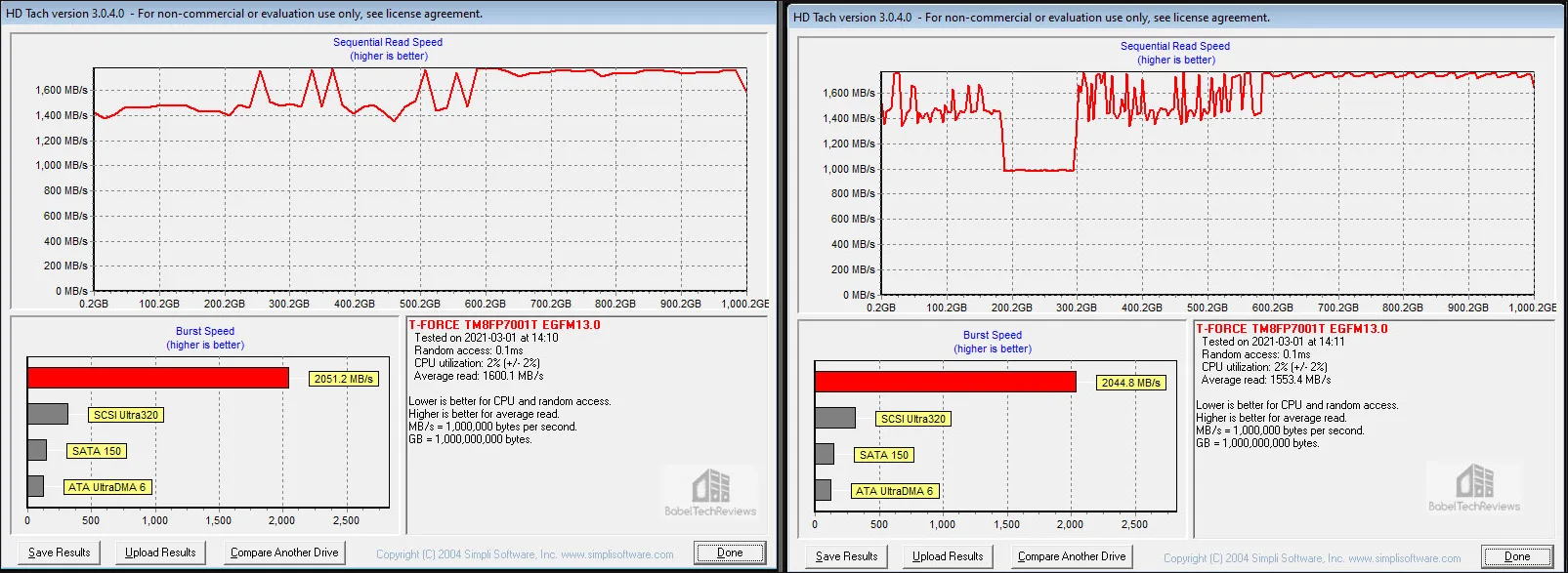
Here are the T-FORCE CARDEA Liquid with an average read of 1529.9MB/s for the Quick bench and 1474.7MB/s for the Long bench. 
Next are the TeamGroup MP33 HD Tach results with an average read of 766.3MB/s for the Quick bench and 791.9MB/s for the Long bench. 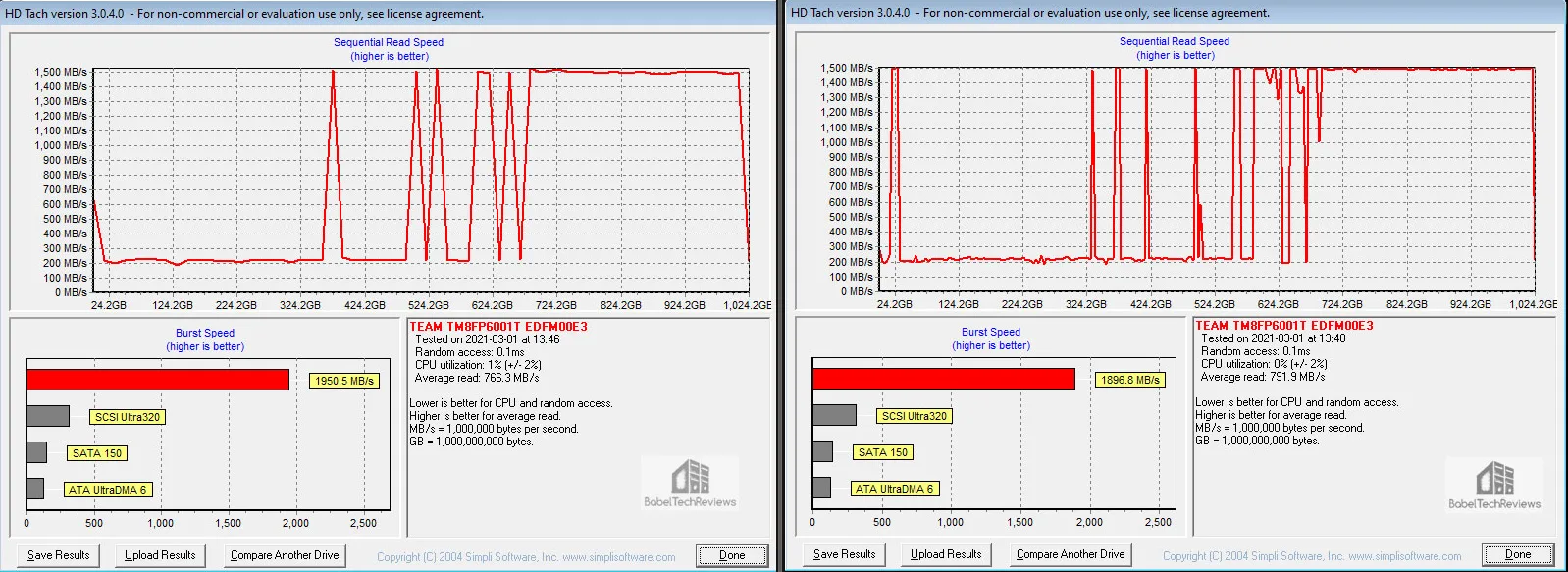
Finally, here are the T-FORCE Vulcan SATA HD Tach results with an average read of 346.4MB/s for the Quick bench and 346.3MB/s for the Long bench. 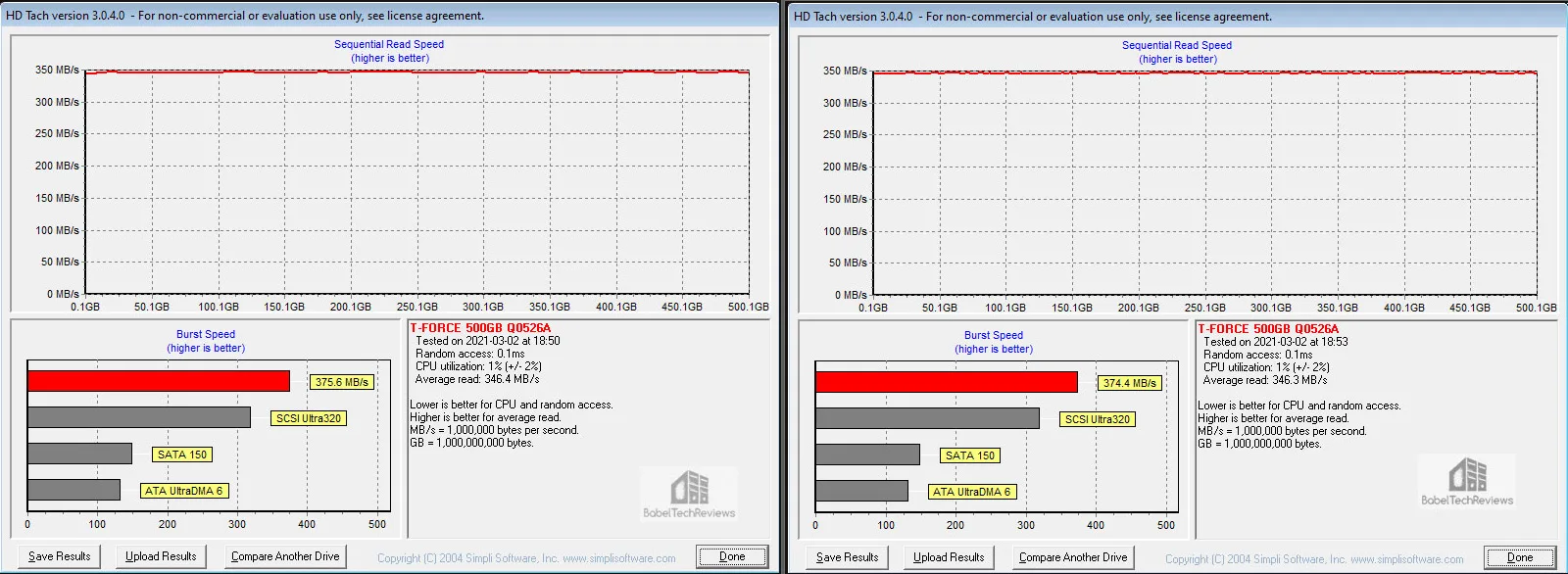 Here are the HD Tach Disk benches summarized in a chart comparing our ten drives. For read speeds, higher is better but for access times, lower is better.
Here are the HD Tach Disk benches summarized in a chart comparing our ten drives. For read speeds, higher is better but for access times, lower is better.
The CARDEA Ceramic C440 is the fastest in HD Tach, and the Cardea Liquid is next followed by the MP33 SSD and in last, the Vulcan SATA III SSD.
Next we look at game/level loading speeds.
The Game/Level Loading Timed Results
Game and game level loading time results are difficult to measure precisely but generally SSDs perform similarly with regard to game loading times and they significantly faster than any HDD. Even SSHDs require loading the same level or program over-and-over to get quicker.
Fortunately we are able to test 2 games using the World of Warcraft and Battlefield 3 loading times again as measured precisely by PCMark 8’s storage test as well as 5 levels and overall loading times accurately by using the Final Fantasy XIV: Stormbringer benchmark.
Let’s start with the Stormbringer benchmark first and the CARDEA Ceramic NVMe PCIe SSD. Total Loading times are 13.34 seconds.
Next the CARDEA Liquid SSD. Total Loading times are 15.295 seconds.
Next the MP3 SSD with total Loading times of 16.098 seconds.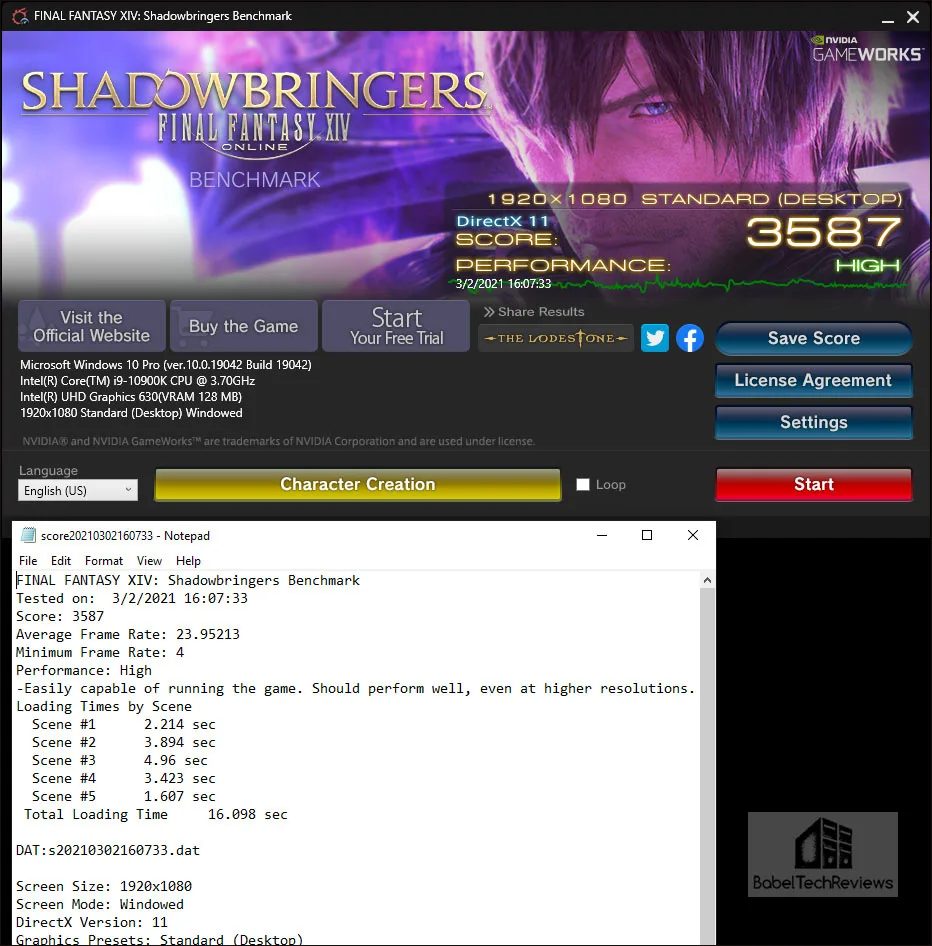
Finally the Vulcan SATA III SSD with a total Loading times of 16.214 seconds.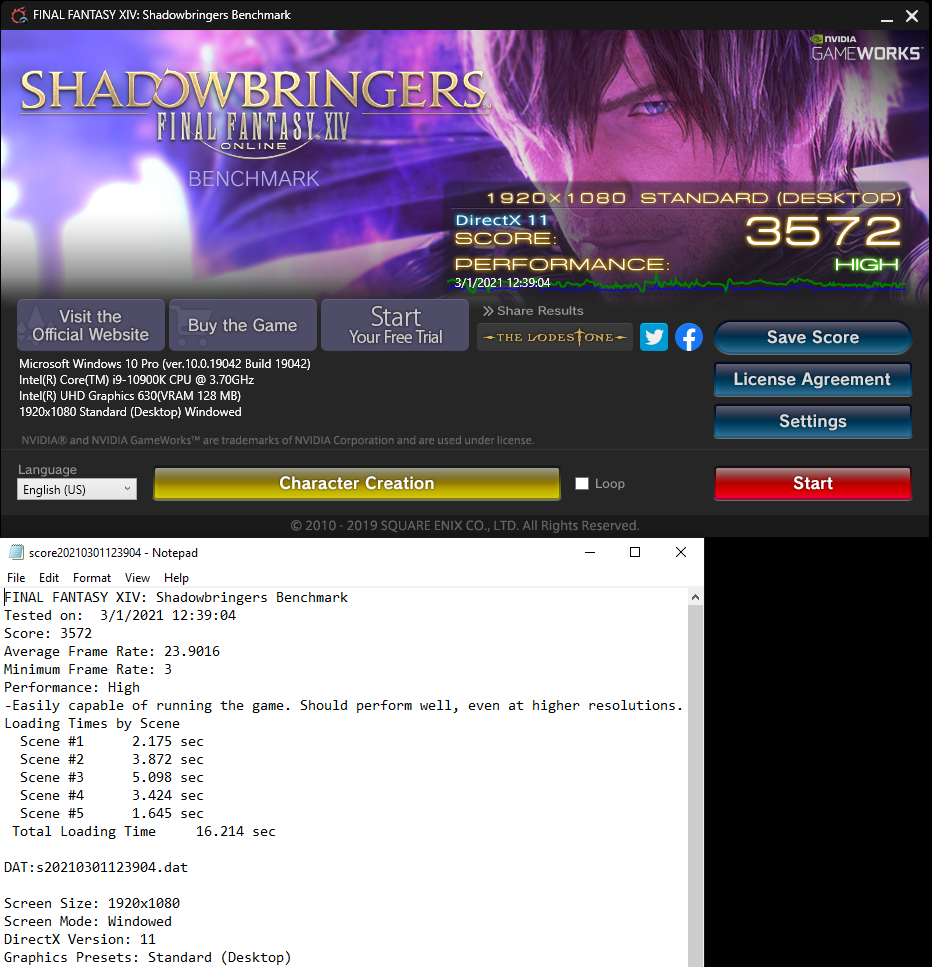 Here is the chart comparing the total loading times of each SSD plus each of its 5 levels. Lower times in seconds are better which means the game or level will load more quickly.
Here is the chart comparing the total loading times of each SSD plus each of its 5 levels. Lower times in seconds are better which means the game or level will load more quickly.
Here are the World of Warcraft and Battlefield 3 loading times again as measured precisely by PCMark 8’s storage test. Lower (faster setup in seconds) is better.
All of the SSDs load games quickly and there is very little difference between them although the CARDEA Ceramic C440 is the fastest followed by the CARDEA Liquid, the MP33 and the SATA III Vulcan SSD. Until developers start to target SSDs for game storage, or perhaps after the next generation of consoles move away from hard disk drives, we may see SSDs achieve the game loading performance they are capable of.
File Copying
File copy speeds are important to gamers especially when they want to quickly transfer their game files from one location to another.
First we copy a 22.8GB folder containing Alien Isolation (which is exceptionally intense in VR) from its Steam folder to a desktop folder which is something we do regularly when setting up VR on multiple PCs.
The CARDEA Ceramic C440 took 20.5 seconds.
The Liquid CARDEA which is a slightly faster drive took almost twice longer then the ZERO Z340 at 40.9 seconds for the same copy.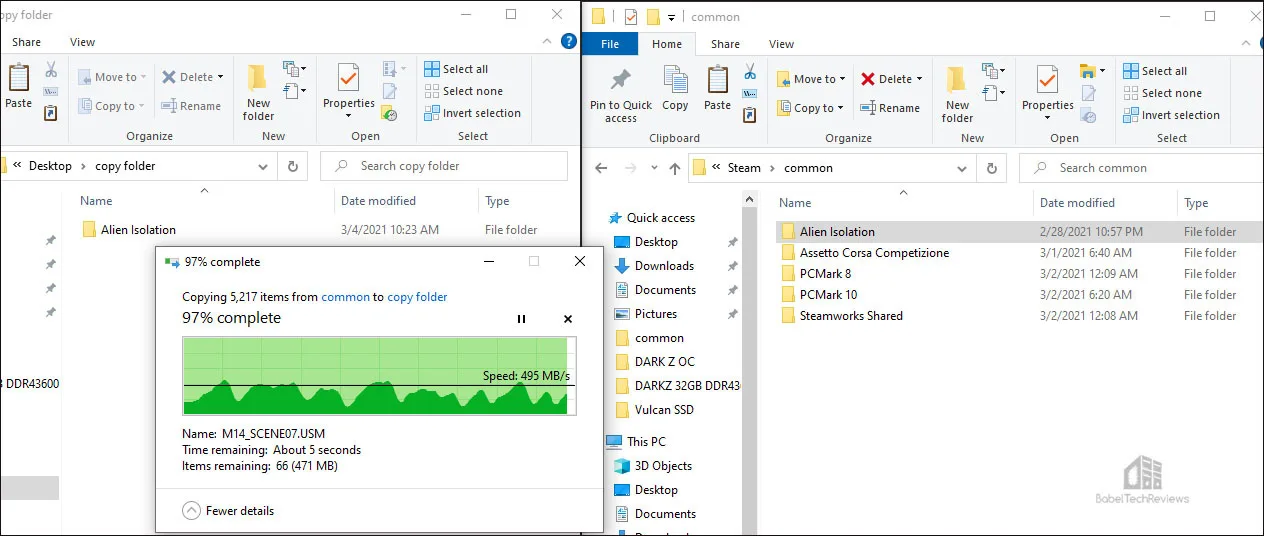
The Team Group MP33 M.2 PCIe 1TB SSD is weak in Read but rather fast for Write evidenced by taking 1 minute and 9.3 seconds (69.3 seconds) for the Alien Isolation Copy, or less than 20 seconds slower than the CARDEA Liquid, but the CARDEA Ceramic is still 3 times faster at copying this same folder. 
It took about 2 minutes and 22.5 seconds to copy the same Alien Isolation 22.6GB Steam folder from program files to the desktop using the Vulcan SSD. You have time to make a cup of tea.
Next we try something a bit more complicated and time consuming when we copy multiple folders totaling 44.2GB from from Steam’s common files to a desktop folder.
The CARDEA Ceramic C440 took 1 minute and 44.2 seconds.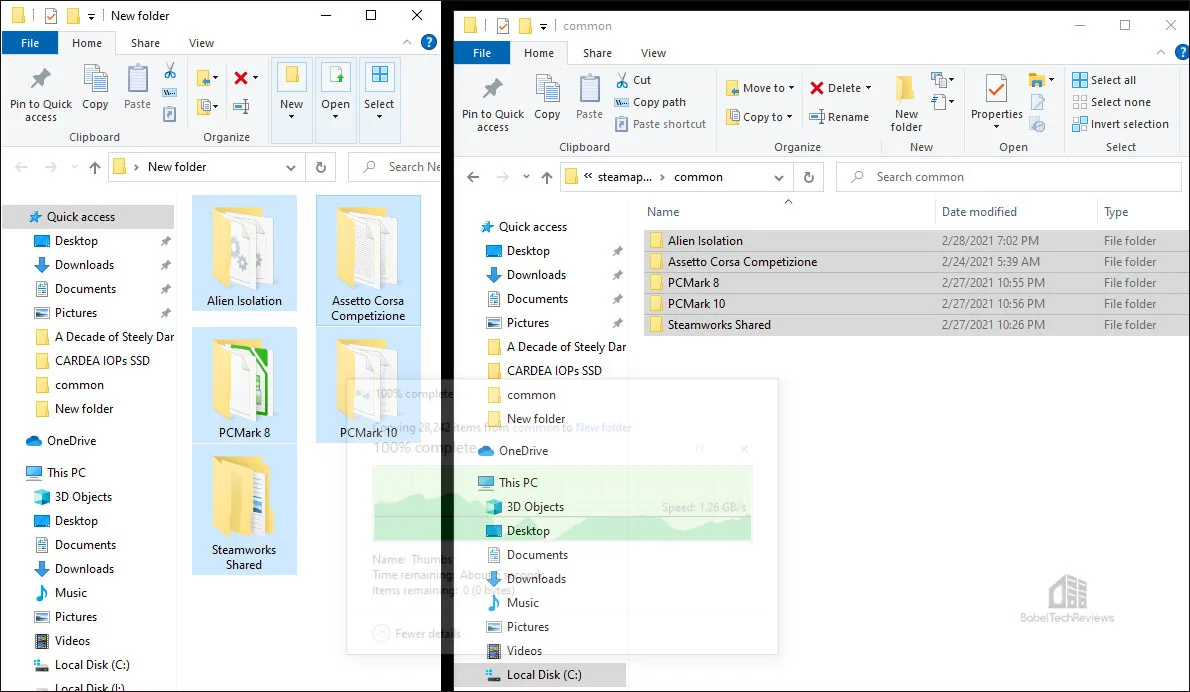
The Liquid CARDEA which is a slightly faster drive took much longer then the Ceramic C440 at 3 minutes 21 seconds for the same copy.
The Team Group MP33 M.2 PCIe 1TB SSD is more inconsistent in its speeds for large files taking 4 minutes, 8.7 seconds.
It took about 7 minutes and 32 seconds to copy the same 22.6GB Steam folder from program files to the desktop using the Vulcan SSD. You can probably get dinner started in that time. But no matter how you look at it, even a SATA III SSD is much faster than any HDD or SSHD when you can probably make dinner and eat it too before your files are ready.
Even when the CARDEA Ceramic C440 SSD is constrained severely by the Intel platform’s limited bandwidth, it still excels at copying compared to any of our other tested SSDs.
Finally, let’s revisit game/level loading times plus all of our Summary charts and then reach our conclusion.
Summary Charts and Conclusion
Here are all of the gaming and summary charts again for easy reference followed by our conclusion.
The Game/Level Loading Time Results
Game and game level loading time results are difficult to measure precisely (such as by using a stopwatch) but generally SSDs perform similarly with regard to game loading times and they significantly faster than any HDD. Even SSHDs require loading the same level or program over-and-over to get quicker.
Here are the World of Warcraft and Battlefield 3 loading times again as measured precisely by PCMark 8’s storage test and accurately by Final Fantasy XIV: Stormbringer’s benchmark. Lower (quicker/faster) loading times (measured in seconds) are better.
All four SSDs load games quickly and there is very little difference between them although the T-FORCE CARDEA Liquid C440 is undisputedly the fastest followed closely by the T-FORCE CARDEA Liquid SSD, then the TeamGroup MP33 SSD, and finally by the T-FORCE Vulcan SATA III SSD. Until developers start to target SSDs for game storage, only then may we see SSDs achieve the game loading performance they are really capable of.
Non-Gaming Summary Charts
Here are all of the summary charts presented again in one place.
A gamer who wishes to have the very fastest PC will prefer an internal PCIe NVMe SSD, and the CARDEA Ceramic C440 SSD is a great choice for a fast drive even when its bandwidth is curtailed by the PCIe bandwidth limitations of current Intel enthusiast motherboards. We can sum up our synthetic benchmarks by stating that the T-FORCE CARDEA Ceramic C440 is the fastest PCIe NVMe drive we tested with the T-FORCE CARDEA Liquid following behind. Third fastest, is the TeamGroup NVMe MP33 SSD, and finally the T-FORCE Vulcan SATA III SSD is in last place.
A gamer will only realize the CARDEA Ceramic C440 fast PCIe Gen 4 x4 speeds on current Ryzen 5000 platforms and on the next generation of Intel’s 11th CPU platforms, and we plan to upgrade at which time we will retire our MP33 SSDs and replace them with a pair of C440s. But for gaming and for regular tasks on current Intel platforms, any SSD will provide similar game and level loading performance well above that of mechanical hard drives or even hybrid drives.
Let’s head for our conclusion.
The Conclusion & Verdict
SSD technology is still improving and it seems that SSD pricing remains reasonable as speeds increase. SSD technology has become much more accessible, and it appears that gamers need more and more capacity as games are getting quite large. We would suggest that 500GB is the minimum capacity for a gamer, and 1TB is better as a primary drive.
It is not mandatory to have a SSD if you use your PC only for gaming and have a lot of patience. Games do not perform better on SSDs since developers still target HDDs for game performance optimization. However, games may take significantly longer to load from a HDD or SSHD than they do from any internal or even an external USB 3.0 SSD. If a gamer wants to get right back into the game, a CARDEA Ceramic C440 SSD will improve immersion and decrease frustration.
Windows 10 is becoming more and more painful to use when installed on a mechanical or even on a hybrid solid state/hard disk drive. Indexing, Search, or Anti-malware Windows programs may often saturate the bandwidth of a mechanical drive, and even downloading or updating Steam games may slow your PC to an irritating crawl. This will never happen using a fast NVMe PCIe SSD like the CARDEA Ceramic C440.
The T-FORCE Vulcan 500GB SATA III SSD can be found for $58.99 and the 1TB version is $105.99; the Liquid CARDEA NVMe2 512GB drive is $82.99, but the 1TB version is $134.99; the Team Group MP33 1TBB SSDs are $91.99. The C440 comes in just two capacities – 1TB at $189.99 and 2TB at $364.99. However, the CARDEA Ceramic C440 drive is currently discounted to $166.99 at Amazon.
It is clear that high speed PCIe Gen 4 x4 prices are priced at a premium, but $32 is not excessively more expensive to pay for the CARDEA C440 over the CARDEA Liquid based on performance even if the Intel motherboard cannot allow it to reach its rated speeds. The C440 is blazing fast and when we upgrade our platform to a next-gen Intel platform or to a Ryzen 5000 platform, we will buy a second 1TB C440 to replace each of our MP33 SSDs as boot drives.
Pros
- The CARDEA Ceramic is significantly faster than any internal SATA III SSD and it faster than the CARDEA Liquid SSD.
- The white ceramic heatsink looks awesome in an all-white or black build and it works well to cool individual component hotspots
- 5-year warranty backed by TeamGroup support
- Fast game/level loading speeds and good file copy speeds
- High speed thin drive
Cons
- We wish the blue PCB was available in black
This has been an enjoyable exploration comparing three other SSDs with the T-FORCE CARDEA Ceramic 1TB PCIe NVMe SSD. The performance of this drive is exceptional for very quick transfer of data or for storing, playing, and launching games – even when constrained by Intel’s limited bandwidth.
The Verdict
 We feel that the T-FORCE CARDEA Ceramic C440 deserves BTR’s “Recommended” Award as a thin, very good-looking, and very fast PCIe Gen 4 x4 PCie NVMe SSD. It’s currently expensive and has a price premium, but it is currently discounted to $166.99 at Amazon. If you have a Ryzen 5000 platform, you will be able to make full use of its rated speed of 5000MB/s Read / 4400MB/s Write unlike with our Z490 Intel platform that limits it to 3400MB/s Read / 3000MB/s Write.
We feel that the T-FORCE CARDEA Ceramic C440 deserves BTR’s “Recommended” Award as a thin, very good-looking, and very fast PCIe Gen 4 x4 PCie NVMe SSD. It’s currently expensive and has a price premium, but it is currently discounted to $166.99 at Amazon. If you have a Ryzen 5000 platform, you will be able to make full use of its rated speed of 5000MB/s Read / 4400MB/s Write unlike with our Z490 Intel platform that limits it to 3400MB/s Read / 3000MB/s Write.
As a fast NVMe PCIe SSD, the CARDEA Ceramic C440 is a great way to store, launch, and play games and it looks great. However, SSD prices change daily so we suggest checking for sales to get the best bang for buck. We recommend the T-FORCE CARDEA Ceramic C440 4 x4 M.2 PCIe SSD as a great choice for a gamer who wants a flashy and all-white thin fast drive with a 5-year warranty.
We are working on our next hardware review that will be a surprise and we cannot say any more about it other than there will be two related reviews – and we will not neglect VR. Stay tuned.
Happy Gaming!
